#encapsulates him so well att
Explore tagged Tumblr posts
Text






Lionel Messi during a LaLiga match between FC Barcelona and Atlético de Madrid at Camp Nou in which Barça won 5-0 and Messi scored a hat-trick, 24.09.2011
#lionel messi#fc barcelona#fcb vs atm#11/12#obese mickey <3#my actual fav pics of him ever#encapsulates him so well att#merciless menace on cocaine humiliating fathers of whole families on the pitch
8 notes
·
View notes
Text
Alright, chapter 206 of "Vinland Saga", and holy shit, what an incredible chapter this was.
All my fears of a convenient or easy resolution to the brewing conflict just evaporated with this chapter.
Starting it out with the natives already attacking Arnheind Village, already slaughtering a family, and juxtaposing that against Thorfinn's attempts to evade conflict, the reader knowing it's already too late, was a brilliant move. I was seriously on the edge of my seat reading this.
And knowing the natives are now heading toward Thorfinn's house, where Gurdrid is in the midst of giving birth, Jesus, the stakes couldn't be higher. Clearly these people have no qualms murdering women, and I'm guessing they have no qualms murdering children either. War has already begun, as the editor's caption at the end says.
I'm really loving this, because Thorfinn's resolve of pacifism has never been more sorely tested than it is now, and I frankly don't see a way out of this while maintaining that vow. Violence has already broken out, and Thorfinn's very family, his wife and children, are in danger. If Thorfinn DOESN'T fight, they could very well die. How far does Thorfinn's resolve to abstain from violence reach? Would he let his own family perish to hold to his vow? These kinds of questions are of course what makes a story like "Vinland Saga" so interesting. What good does an avoidance of conflict amount to if innocent people die for it?
And then there's Einar and Thorfinn's own, emerging conflict. To see it come to this between them is heartbreaking, but incredibly realistic. Einar is Thorfinn's first and best friend, and yet they're at what seems an impasse. Einar's refusal to leave, and his declaration that no one else will leave either, is true to reality. All of the Nords worked too hard, sacrificed too much, to just agree to leave. Thorfinn's idealism is starting to run into harsh reality, and it isn't going well. When Einar accuses Thorfinn of caring more about his vow not to kill than he does the village, this is also a harsh clash of reality against his idealism. Again, he's faced with a vital question. What's more important to him, making amends for all the lives he previously took by creating and sustaining a world and a life for people trying to escape war, or his vow of pacifism? An even more impossible question, how can a world free from war even exist if you aren't willing to fight for it? I really like this. Because it's presenting the incongruence of a totally peaceful world. It can't actually exist. In order to defend something and sustain it, violence can't always be avoided. You can't always refuse to fight. Because there's always going to be someone or something which threatens it. Thorfinn's conflict with Einar really encapsulates this. At a certain point, you have to choose. Hold, without compromise, to an impossible, personal ideal, or fight for the lives of others. Einar isn't wrong when he tells Thorfinn his continued insistence that the Lnu aren't their enemies is stupid. They are because they refuse now to allow the Nords to stay, under threat of violence. That's an enemy. A world without enemies was only ever a fantasy. The impartial and unbiased spread of disease ensured the impossibility of pretending otherwise any longer. There's always going to be a situation of it being either us or them.
Now, the attack on Arnheid Village is all the more devastating. It really is too late to avoid war now. They've killed a man and a woman. Two members of the community. And they're headed for Thorfinn's home next. This presents further, terrible questions. There are no weapons in the village, the very thing the natives are looking for. Thorfinn's insistence of bringing no means of defending themselves could very well cost lives now. The irony, of course, is that it was Ivar smuggling weapons into the village in the first place that ignited the native's greed, and encouraged them to attack to begin with. Further irony is in the fact that Thorfinn's own pacifism is what lead to Ivar attacking the Shaman in the first place, convinced as he was that Throfinn was weak and wouldn't be able to defend himself. "Vinland Saga" really is presenting both sides of the argument now. It's both Ivar's violence and Thorfinn's pacifism that has contributed to the current state of things.
But the Nords aren't going to be able to be talked out of all out war, at this point. First blood has been drawn, and there's no way they're going to listen to anything Thorfinn has to say any more about not fighting.
I really don't know what's going to happen now. Thorfinn and his group are being pursued by the war party of natives, and his village is under attack, with Gurdrid and Karli and the others all in danger. If Thorfinn can't make it back to the village, his family might die. And if they do, what would be Thorfinn's reaction? How would his vow of pacifism even hold up to that? Or if he is able to make it back to the village in time, I can't imagine he'll just stand by and let his family be slaughtered. He'll have to fight to defend them. He may even have to kill.
This is by far the best chapter of "Vinland Saga" in a while, and one of the best of the entire series, I think.
Things are really starting to come to a head now, and I can't wait to see how this develops. The two month wait is gonna' be hard to take.
26 notes
·
View notes
Text
Touka and Kuzen - contrasting managerial styles

TG 143
I wanted to take a look at Touka and Kuzen through the lens of how they handled situations differently, and how they handled their creations of cafes for their loved ones. It’s well known that Touka’s creation of ;re paralleled Kuzen’s creation of Anteiku. However, Ishida goes out of his way to show the immense differences between these two characters. This difference, and how it came to be, is portrayed in their backstories, and how they carry themselves in the actual story. This post will cover things in both TG and TG;re.
So, to start with, we’ll cover Touka’s backstory. Then, we’ll cover Kuzen’s backstory. Then, we’ll note the difference between these two characters, how it shows in their backstories, how it shows in their characters, so on and so forth.

TG;re 71
Touka’s first encounter with tragedy is at a very young age. Her mother and father are engaged by Arima. While her mother holds them off, her father escapes with her and her brother. The loss of her mother leads her father to engage in ghoul cannibalism and developing a kakuja. Eventually, he ends up running into multiple ghoul investigators lead by Shinohara and Kureo Mado and is captured by them.
There are two versions of the stoy here - according to Yomo in TG;re 71, Arata was targeted for his power. Touka’s story in TG;re 120 is that her father was killing ghoul investigators; there, we learn she laments her father’s decisions, and blames herself for his actions.
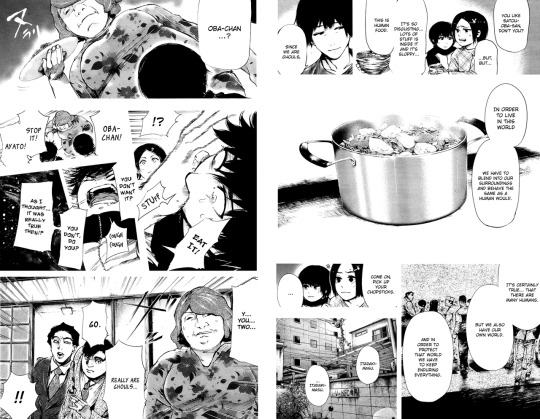
TG 71, 70
Touka and Ayato end up being turned into the CCG by the very human neighbors their father encouraged them to trust, respect, and make sacrifices for. Touka is forced to kill one of the CCG agents that attempts to capture them as a result, and they flee.

TG 71, 70
Of course, before he left, her father instilled lessons on Ayato and her. These aren’t the only ones, of course but they are the ones we’ll be discussing. Before leaving, Arata instructs Ayato that he must keep his sister safe. For Touka, he instructs her that she must teach him about life. These are things that parents often say to their children, but it ends up taking on a different meaning for Touka and Ayato due to their childhood. Because of their circumstances, Touka ends up shouldering these burdens herself, quite literally, in the form of Ayato.
Now, lets talk Kuzen.

TG 119
Kuzen grew up completely alone. He never had anyone but himself to rely on - as a result, he ended up killing countless humans and ghouls. He started cannibalizing at a young age not for the reason that many other characters do - loss of others and the desire for strength - but instead because he wanted to live a long life and not go hungry (this is reminiscent of Roma’s backstory TG;re 135). Because of his strength and willingness to kill, he comes into contact with V. V provides him with food, shelter, and clothes, and in exchange, he continues what he’s already doing - killing. Kuzen’s needs in regards to safety, food shelter, and clothing are met. However, he feels unfulfilled.
The hierarchy of needs is not necessarily linear, but, generally speaking, it goes like this: human beings have physiological needs (eg food, water, shelter), safety needs (eg not fearing death), esteem needs (eg a career), social needs (eg love and family), and finally this leads to self actualization (eg fulfillment of one’s potential). Kuzen’s physiological, safety, and esteem needs are all being met by his employment by V. However, he still lacks loving and belonging. He still isn’t reaching his potential.
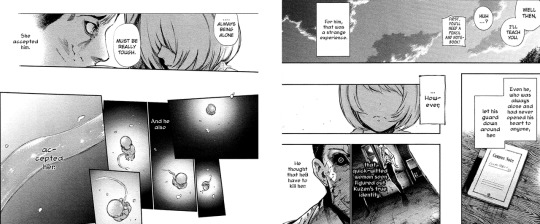
TG 119
And in comes Ukina, serving Kuzen coffee. Ukina was, according to Kuzen, an undercover journalist. The topic of her current story was V, the organization Kuzen worked for. Kuzen believes that Ukina was unaware of his status, as he was of hers, and that they happened upon one another. Eto provides a different version of the story - Ukina approaches her father because she’s aware he’s a member of V (TG;re 64).
Ukina is the first person Kuzen ever connects with intimately. She teaches him how to read the complex kanji he cannot understand. Through Ukina, Kuzen finds a place of belonging and higher fulfillment. Kuzen gets close to Ukina; she accepts him even after she finds out he’s a ghoul. Kuzen spares Ukina, and they eventually have a child together.

TG 119
Eventually Ukina’s objective is found out. Of course, V cannot let that stand. V orders Kuzen to kill Ukina. He does so, with Ukina’s last words being her remarks about his loneliness. One thing I want to note here is that, contrary to popular belief, Kuzen didn’t leave V. He simply stopped being part of their secret police. He just flat out says this, in much more polite words. That’s what “unable to cut ties” means. That’s why every time he goes to “work”, he’s wearing a V uniform. It’s why Kaiko can just walk right up to him later on in Tokyo Ghoul. There’s a reason why Eto was left in the 24th ward, after all.
This isn’t to say Kuzen didn’t make his own moves against V (such as sheltering Rize from their view), but that doesn’t mean he wasn’t a member still. All of the members of V are shown making moves against other members of V - eg, Kaiko, introduced as the face of V, helps Furuta kill the Washuus who are supposed to be higher ranking members of V. Arima and Furuta are both members of V and make their own moves against it. Matsuri also immediately considers members of V to likely be the culprit behind the attempt on his life. V in general is a very Darwinian organization that seems to compartmentalize and encourage, unintentionally or not, competition among its members as is common with authoritarian organizations.
Now that we’ve established these backstories before they began interacting in universe, lets take a look at how these two characters interact, and how they play off one another.

TG 71
There are substantial takeaways from these backstories, and what these characters actually value at heart. Kuzen’s story is a story of loneliness preceding tragedy - Touka’s story is a story of loneliness succeeding tragedy. Kuzen was always alone, but surviving. That is his state of being. It is what he knows. Touka’s situation was always with a family - making sacrifices to protect family, to survive with family. While both Kuzen and Touka ended up alone for a time, their actions and reactions are different.
It’s best encapsulated by Kuzen’s words to Touka after he hears of her and Ayato getting into a fight Tsukiyama, and splitting up once again. Kuzen’s words to Touka here aren’t exactly subtle - he’s not exactly being coy about implying Touka should prioritize herself over Ayato, by noting that fighting for family and food has its limits before mentioning Ayato’s violent tendencies. Kuzen then implies that Touka going for school and working at Anteiku would help her do better with Ayato. This makes no logical sense, however.

TG 71
The tragedy of Touka and Ayato was, from Ayato’s point of view, caused by humans. Arima took away their mother, followed by their father being taken away by Shinohara and Mado, followed by almost themselves being taken away by their own neighbors. They were betrayed by the very humans they suffered for at their fathers request. Touka is not only going to school with more humans, becoming friends with humans, she’s also spending time at Anteiku working as a human waitress, seving human customers, to pay Kuzen back. As a result, Ayato is being left alone, unchecked, and unguarded. Ayato gets upset and ends up running away, causing even greater chaos than he did when he was with Touka, and in much greater danger as a result.
This isn’t Touka’s fault. She’s a child herself in a very rough situations. Children running away from home isn’t uncommon, especially when they’re under stress and they feel they’re unappreciated and unloved, as Ayato does here. That doesn’t mean that he’s actually unappreciated or unloved, of course. The difference between a normal human teenager running from home, and Ayato running from home, is that Ayato’s family, in the form of Yomo and Touka, aren’t doing the smart thing and coming after him. They’re just letting him run rampant. Now, fortunately, this ends up working out for Ayato (YMMV) in that Aogiri Tree takes him in, rather than the CCG, or a rival ghoul gang that was angry at his attacks.
However, this is still the exact opposite thing that Kuzen intended. If it wasn’t for things that Kuzen couldn’t have predicted (eg Tatara), Ayato may very well have died. This is kind of a repeating pattern with him and it goes understated. So, before we go any further, lets go over his and Eto’s backstory again, before we get back to Anteiku.
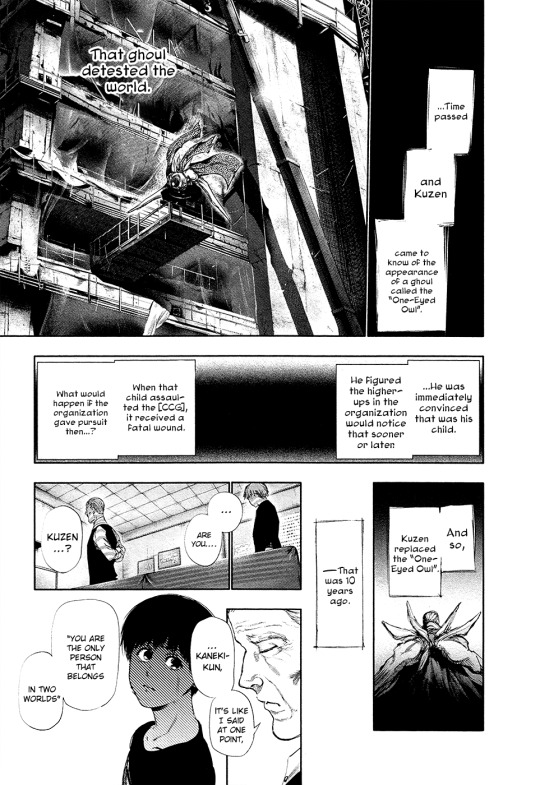
TG 119
Ishida actually demonstrates how this plan failed, but lets go over this story, because there’s some obvious flaws with it.
So Kuzen leaves Eto in the one place that V will never find her. Inexplicably, Eto just comes out of nowhere, “filled with hatred of the world”, and decides to attack the CCG. During these attacks, she receives a lethal wound. Fearful that V might pursue Eto in addition to the CCG, Kuzen becomes Eto’s substitute and attacks a random CCG base, receiving a lethal wound himself.
Okay, lets start with Eto’s motivation for her attacks. This is only going to be briefly covered, because the Eto/Touka parallels post covers this attack more thoroughly. Eto didn’t just pop up out of nowhere, as we know, she was actively being hunted by V and the CCG to begin with.
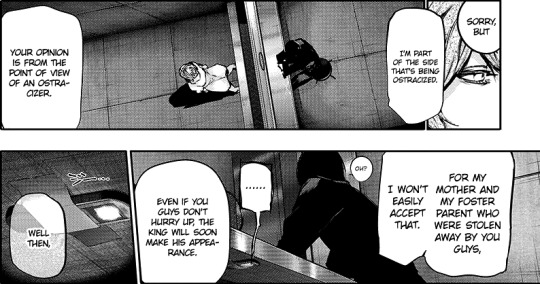
TG;re 66
Noroi ended up like Noro because V killed him. Shortly thereafter, as coincidence would happen, the CCG decided to do a “whack a mole” operation where they run into Eto at the specific coordinates they were sent to investigate in the deep section of the 24th Ward. It really can’t be stressed just how low the odds of this are.

TG;re 127, TG 80, TG 95
The Goat base in the middle of the 24th Ward in the D sector was 5 kilometers below the surface. The place they were attempting to escape to by going deeper was E14. Sector F124 is described as being part of the “deep”. We’re not given any reference points, and because V14 was just below the surface, it’s not necessarily linear. However, Eto was still located over 5 kilometers beneath the surface at the minimum.
The 24th Ward is a highly confusing, inconsistent labyrinth that is incredibly hard to navigate. And yet somehow, inexplicably, Marude’s team happen to run into Eto in the deep section they were sent to investigate. The implication here is that V failed their mission of killing Eto, and then tried to follow up with the CCG to kill Eto.
Why do I say the CCG’s battle with Eto occurred shortly after Noroi was killed? It’s simple.
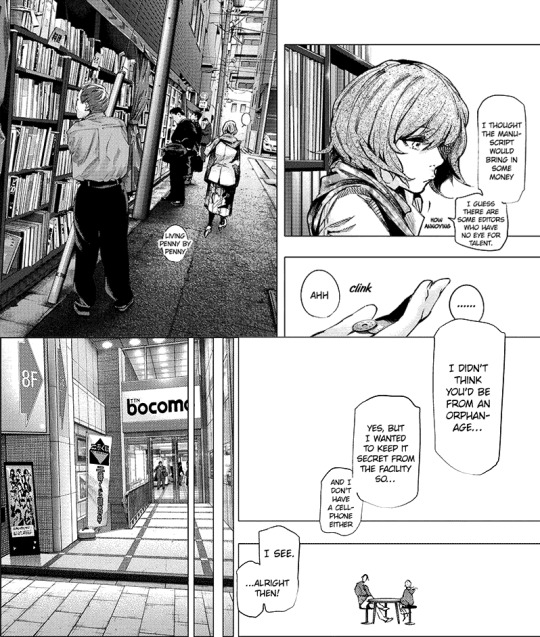
TG;re 62
Noroi isn’t present with Eto when she is attacked by Marude’s team. You’d think that as her protector, he would be. Even Noro isn’t mentioned at any time for the original Owl campaign, despite being a known as a powerful fearsome ghoul of Aogiri. Eto’s also explicitly a penniless orphan right after her rebellion.
This is the first sighting of the One Eyed Owl and Eto cited both her mother’s death and Noroi’s death as a reason she cannot accept V, and Eto’s battle with Kasuka Mado is a parallel to Touka’s and Hinami’s fight against Kureo Mado, wherein Eto plays the part of both Hinami and Touka.
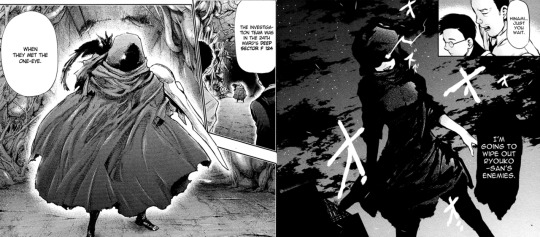
TG 124, 16
Eto didn’t just pop out of the abyss a fully formed kakuja that just hated the world. She didn’t even have a kakuja when she started her campaign, it’s shown as just a kagune. She was provoked by the the world controlling fascists that were intent on killing her and even went looking for her in the place that her father said would protect her from them to begin with. Kuzen knows, even after he “protected Eto”, that V was still pursuing her. We know this because he explicitly says so.
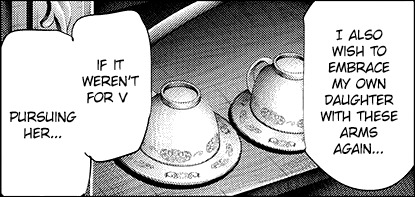
TG;re 71
So, lets move on to the part where Kuzen says he protects Eto. Eto receives a “lethal” wound…

TG;re 61
…that isn’t lethal to a kakuja one eyed ghoul. She literally lost an arm. It’s just damaging her combat ability to the point she was forced to run against multiple special class level investigators with reinforcements on the way. This type of injury is a non issue when it comes to “survival” to someone like Eto, who can, for example, be sliced in half and then chucked off the top of a skyscraper and survive. A ghoul’s regeneration is only stopped when their kahukou is severely damaged.
Then Kuzen takes her place without informing her or coordinating with her, and then also receives a “lethal” wound…

TG 69
And this somehow makes V and the CCG stop pursuing Eto because why, exactly? What changed here? If anything, shouldn’t the CCG and V be more enticed to go after the Owl, as it just received yet another supposedly lethal wound, if said lethal wound was really considered significant to begin with? It’s not like Kuzen immediately stepped in minutes after Eto received her wound and covered for her while she escaped. She explicitly escapes on her own.
Lets look at the logic here from two perspectives, one where Eto is in hiding and the CCG and V don’t know her identity, and one where she’s in hiding and they don’t.
If Eto was in hiding, and CCG and V didn’t know who or where she was, they wouldn’t be able to find her immediately to finish her off anyway. She’s in no immediate danger danger of being attacked as long as she’d not found. In that case, Kuzen’s attack is pointless. Actually, it’s less than pointless - it’s pinning an attack she had nothing to do with on her, and giving the CCG valuable anti-Owl experience to use against her due to the similarities of their kakujas.
If the CCG and V does know who she is, then it doesn’t matter if Kuzen attacks again. This attack doesn’t change the fact that, in this theoretical scenario, Eto’s identity has been exposed. Kuzen’s just getting into another fight that is pinned on Eto and changes nothing.
How does this stop Eto from going on the offensive again and running into V or the CCG? What’s stopping the CCG and V from going after Eto while Kuzen’s faking his attack? Now that Kuzen just ran into some random fight completely unrelated to Eto and received a “lethal” wound, how will he be able to help Eto if she is attacked? The answer is “it doesn’t do any of that”, because we know what ends up happening.

TG;re 86, 69, 52
Arima engaged Eto so close to the time frame that he engaged Kuzen, you can even see that Eto hasn’t even gotten enough time to regenerate her arm yet. Eto was made into a figurative quinque of Arima’s at the age of 14 because Kuzen’s attempt to protect her had no logical way of doing so.

TG 139
Because Arima wasn’t referring to a replacement for IXA here when he said he needed a quinque. Because Kaneki was not literally a quinque he went around killing ghouls with. Arima was referring to a new metaphorical quinque to replace an old one. The old one being Eto.
This isn’t fridge logic, this is something Kuzen should have thought about immediately, and it’s not like he didn’t have time. Kuzen says that he immediately knew that Eto was his child, and consider the description of the Owl campaign.

TG 69
Kuzen had months to think of a plan to help Eto. This was what he decided to do. Kuzen’s plan was liable to fail. It never made sense to begin with in any way, shape, or form to accomplish its goal to save Eto, and so of course it didn’t. Why would it? Kuzen’s not solving any of Eto’s problems - making her feel loved, actually protecting her, giving her guidance.
If it weren’t for Arima secretly hating V and his job, and Eto telling Arima she wants to “fix the world” she would have been killed. Eto survived because of Eto. Lets compare this to Touka, who was in a similar situation with Hinami
If you’re wondering “what should Kuzen have done?” the answer is to ask Touka, who actually succeeded at her goals.

TG 23
I talked above how Volumes 2 and 3 of Tokyo Ghoul are effectively a parallel between Eto, and Touka and Hinami. It’s well known that Touka’s creation of ;re was meant as a parallel for Kuzen’s creation of Anteiku. There’s a reason for this. Lets take a look at how Touka handles the situations with Hinami and Kaneki that Kuzen’s also in, shall we?
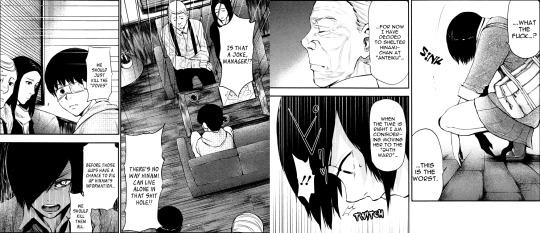
TG 16
Kuzen left Eto in the 24th Ward. He tries to do the same with Hinami. Immediately, Touka gets enraged. You can’t just leave an orphaned 14 year old alone in the 24th Ward. The 24th Ward is considered one of the worst places in Tokyo Ghoul to live, let alone for an orphan. Children shouldn’t be left unattended in general…
While Touka’s reaction here (”Kill all the doves”) is an overreaction, it’s an overreaction to Kuzen’s overreaction. And yes, this is an overreaction. What logical reason is there for Kuzen to throw Hinami in the 24th Ward? I think it’s safe to assume it relates to the CCG confrontations that he gives moments later to Touka’s idea of killing all of the CCG.

TG 16
That still doesn’t make sense, though. Because even if he’s not on the radar because of his connections with V, Kaya, Koma, and Yomo are. A ghoul’s face being exposed is a big deal, yes, but the investigators had no knowledge of what Hinami actually looked like, and a simple investigation of his own could have solved that.
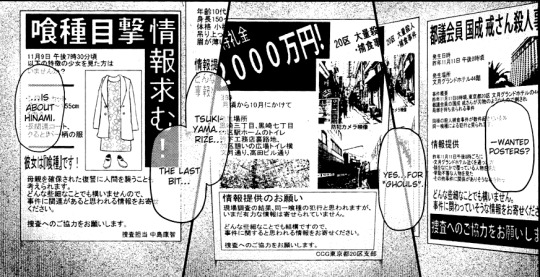
TG 20
To clarify this description is so vague as to be meaningless. It’s basically saying “this vaguely child sized person with a clover dress and a coat”. Hinami literally has to change her clothes and survive a few months and she’ll no longer fit this description in any way. In the end, there is a middle ground between these two sides - Hinami stays with a member of Anteiku and they protect her, and that’s exactly what happens anyway.
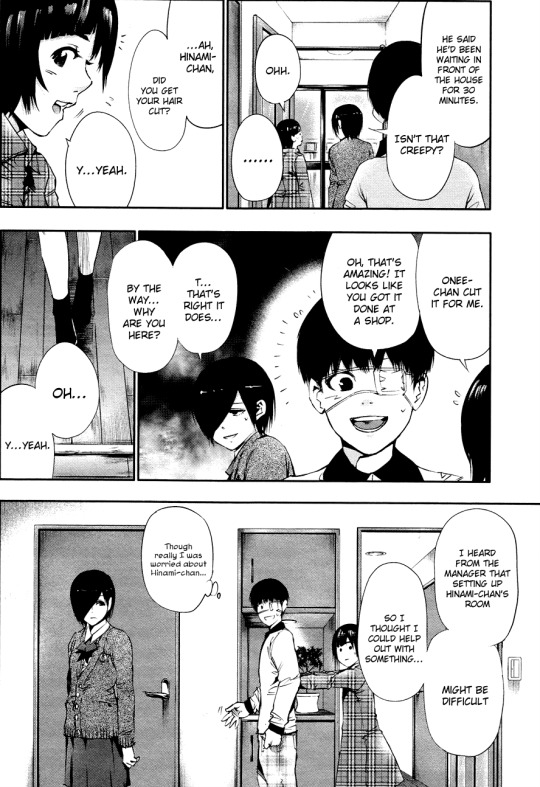
TG 31
Oh and also Hinami gets a haircut, grows because she’s still growing, and changes her clothes. Because she’s alive. The thing is, this is such an obvious and simple answer to the problem at hand that it should have been Kuzen’s first reaction. Touka’s not realizing this immediately is logical. Touka herself has a history of losing people to the actions of the CCG - her own parents directly, and indirectly Ayato. Touka being blinded by her rage is understandable.
Kuzen, meanwhile, has no excuse. He’s many times her age. He’s coolheaded enough to realize not to attack the CCG, and he’s old enough that he should have experience to realize the flaws in his logic. Again, like with his decision to “help” Eto, this is not a split second decision.

TG 17
As a result of him not doing so, the very thing he was trying to avoid, Doves dying, ends up happening anyway. And the very result he was trying to avoid, vengeful Doves, follows. This is a pattern with Kuzen’s actions. His actions keep leading to results he doesn’t want, because his actions have no logical basis of succeeding at anything he claims he wants them to.
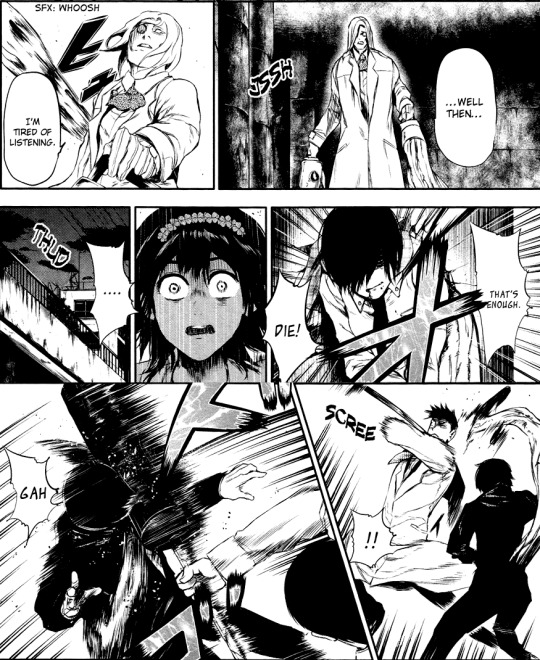
TG 25
Kaneki, Touka, and Hinami subsequently are all almost killed. Kuzen and Yomo eventually show up, but they were mainly preoccupied with Kaneki and in the case of Touka it wasn’t even a last second save Hinami did. Kureo Mado’s quinque was in the midst of being swung meters away aimed at Touka’s head when Hinami cut it off.
All because Kuzen lacked the foresight to think that abandoning an innocent 14 year old in a hellhole was a bad idea. And he really should know better. Kuzen left Eto in the 24th Ward after Noroi died and he got… obvious results.

TG 32
Lets move on to Kaneki’s encounter with Tsukiyama. We’ll start this by making an observation of Touka warning Kaneki about Tsukiyama. This might seem insignificant, but it’s not. Touka’s warning almost worked, were it not for Tsukiyama’s cunning and Itori’s goading, Kaneki would have likely avoided the Gourmet Arc. It’s rather interesting comparing this to both Itori and Tatara’s commentary on Kuzen, where they both make a good points about Kuzen’s treatment of Kaneki.

TG 34, TG 54
There was literally no good reason for Kuzen to not warn Kaneki of the impending danger around him. We know Kuzen’s reasoning here, according to Yomo, it’s to keep Kaneki from getting caught up in the confusion. The problem is that’s already too late. Kuzen already knows Kaneki’s mixed up in V’s business, the CCG’s business, and the Clown’s business, whether he likes it or not. He knows, and decides not to tell Kaneki.
To get back to Tsukiyama, Kuzen’s reaction shows, once again, a lack of learning anything.

TG 40
This is one of the many times that Yomo starts to questions Kuzen’s decision, but doesn’t fully follow through with the thought process. And it’s hard to do so, which I’ll get into later, because Kuzen has many redeeming qualities. But that doesn’t change his downsides. Remember, his inaction almost resulted in three of his people getting killed, and resulted in two members of the CCG getting killed.
Tsukiyama himself literally almost just had Kaneki tortured to death and eaten alive by a group of hungry ghouls. They just finished having a conversation with Kaneki about this very issue. Yomo is clearly worried about Kaneki, and he has a very good understanding of his strength because he’s been training him. This is not stuff that has not already come to pass - this is stuff that has passed.

TG 40
Que Touka, almost as if it’s a joke and she was listening in on them. As if her expression directed at the discussion and Kuzen’s poor decision making, and not Loser. As if it’s meta commentary.
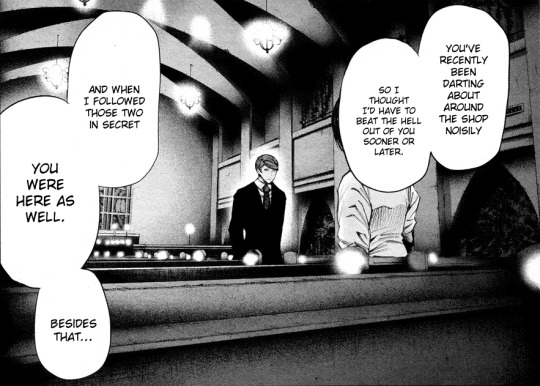
TG 42
Touka picks the opposite decision that Kuzen does, and is in the right. Had she not shown up, Tsukiyama would have likely eaten Kaneki and Kimi, and killed Nishki. You can’t really be hands off when the guy in question is trying to kill one of your people, you know? But Kuzen doesn’t see it that way.

TG 18
You could say that, in a sense, Touka is paying Kaneki back for his own disregarding of Kuzen’s direct orders saving her in the process. One of the patterns that goes hand in hand with Kuzen constantly getting the worse outcomes is of course, characters going against Kuzen’s will and getting improved outcomes.

TG 59
Kaneki’s rescue from Aogiri is actually an example of Kuzen doing the right thing. Still interesting to note that Touka immediately knows she’s going to save Kaneki and makes it known, which contrasts with Kuzen’s malingering on the issue.
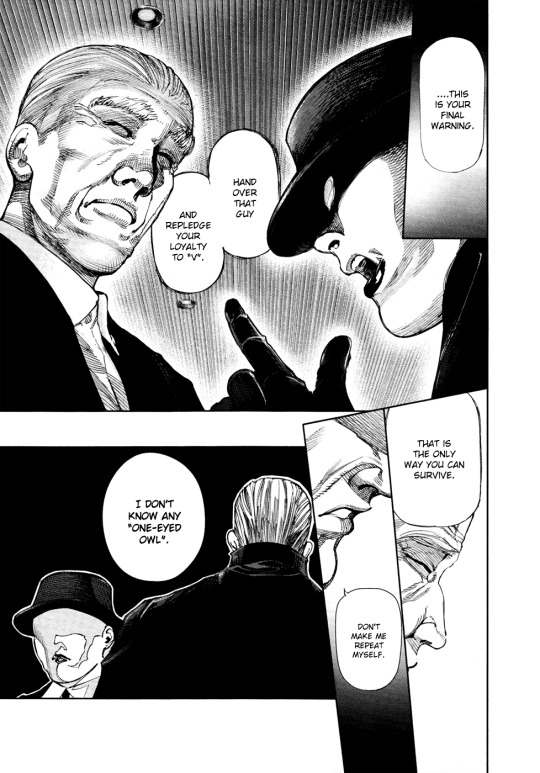
TG 124
Kuzen’s stand at Anteiku was also just pointless. He frames it as a stand against V for Eto when Kaiko chats with him, but how does fighting at Anteiku do so? How does this protect or help Eto? How does fruitlessly dying against the CCG stop V from going after Eto? Again, it doesn’t.
Even if Kuzen was going to be chased by V, we know you can avoid them for years with occasional fighting (see: Shachi, Noroi and Eto, Rize pre-Binging). And if you actually want to fight them, there are better means than playing defensive against a bunch of CCG agents protecting literally nothing.

TG;re 140, 65
It’s not like this is like Rushima and Coachlea, where the goal is to split the forces of the CCG to enable a rescue operation. The diversion Aogiri Tree made was an absolute necessity for the success of the Coachlea raid. And it’s not like there are countless numbers of noncombatants who couldn’t defend themselves if Kuzen didn’t fight, like in the 24th Ward. The stand made there was a necessity to stop the slaughter of civilians.
Kuzen didn’t have to fight, and neither did the Dobermans or the Apes. A lot of people just ended up dying for no reason. Anteiku was just a place that could have been rebuilt, which is exactly what the rest of the Anteiku crew sans Kuzen and Kaneki did. It was literally a building, the people inside the building are what mattered. And Kuzen decided they had to die and then effectively blamed it all on Eto. Because regardless of whether or not that’s what he intended, that is what he did.
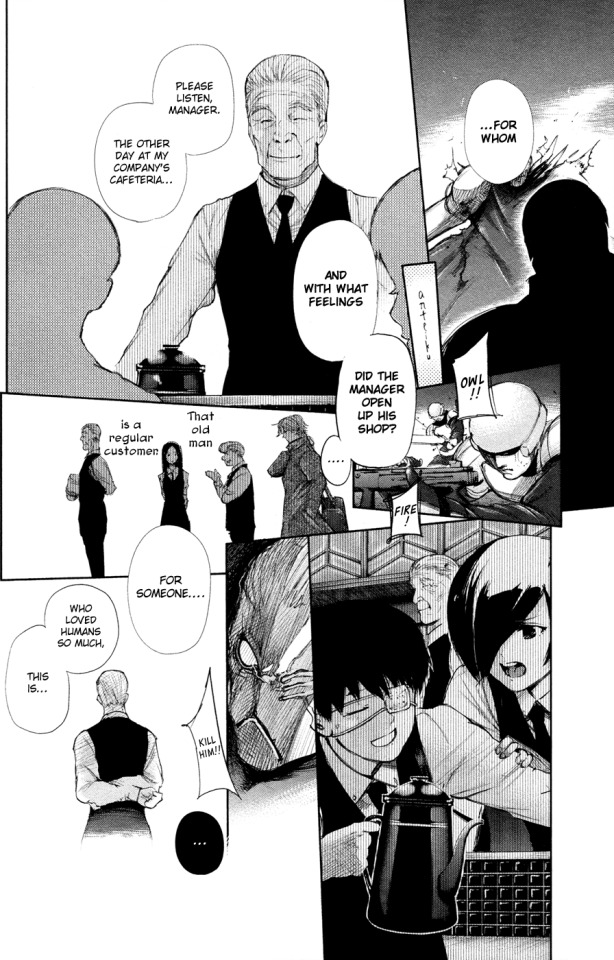
TG 128
Kaneki is clearly implying that this entire battle, this entire fight is entirely Eto’s fault here, he’s just not saying her name. We’ll get back to this later on, because it’s important, and it explains a lot of the Anteiku/Eto interactions.
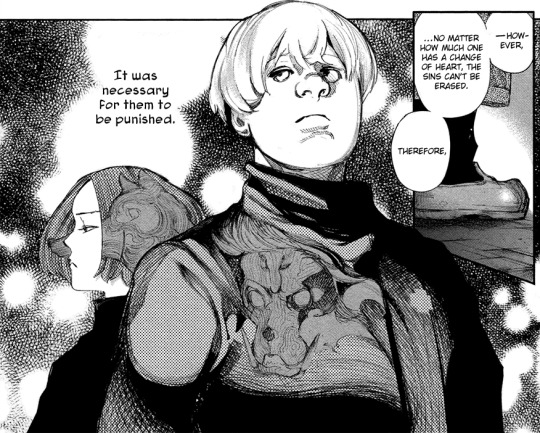
TG 130
Now the Anteiku raid itself. Kuzen framed the entire thing as a fight for Eto. He brings Kaya and Koma along with him, but as noted above, this doesn’t actually help Eto in any way. As noted above, if Kuzen just ran away, hid himself, anything, really, there would be no consequences to anybody.
Touka attempting to rush to Anteiku was a foolish move, and it makes sense that Yomo stopped her. The problem is Yomo’s response to Touka’s response. Touka’s the only person in this situation who’s actually shown putting any thought into the situation, and yet she’s being belittled for it.
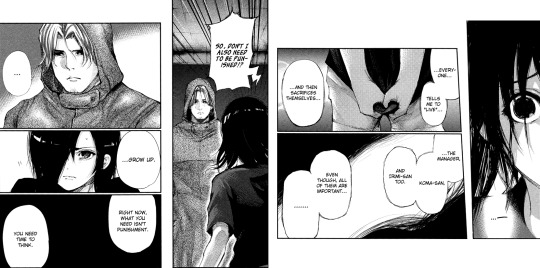
TG 130
Kaneki, Kaya, Koma, and Kuzen are all on suicide missions for no good reason, hoping that things will work out. Touka is desperately trying to understand, but can’t, because there is no logical reason for this to happen. People are just dying over a literal building. Touka’s objection destroys Kuzen’s argument here about redemption through death and how arbitrary he makes it. Yomo really has no good responses to Touka’s objections here, he just deflected with saying she’s too young to understand the thing that he himself doesn’t understand. He even outright agrees with her.

TG 130
He tries to play off her being confused by a senseless action leading to countless deaths as her “throwing a temper tantrum”. He adopts Kuzen’s policy of inaction once again, even though he feels this is all wrong. He even acknowledges this years later.
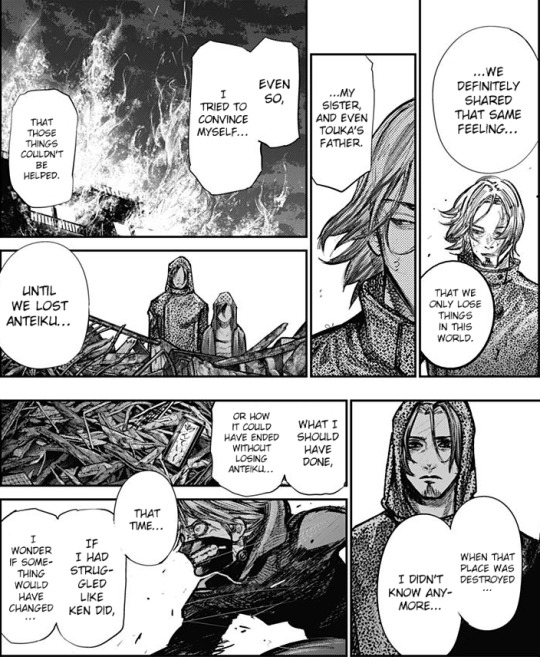
TG;re 171
The problem is that he still doesn’t see the pointlessness of Anteiku, here. No one does. Even Nishki and Kaneki were trying to rationalize the battle as Kuzen trying to cause enough chaos that the Anteiku crew would not be found.
“Or how it could have ended without losing Anteiku…”
We are literally shown how to have ended the situation without losing Anteiku, outside of a name change. It’s literally a situation that Yomo himself was in just months before in universe. It’s just that Yomo can’t bring himself to acknowledge the reality of Kuzen’s actions. He somewhat seems to have started to understand it towards the end of ;re, but not quite. On some level, he’s still trying to justify the battle. “Maybe if I had fought in that battle” is just that. The right answer would have been to… not fight.
So, what was Kuzen’s real reason for the battle of Anteiku?

TG 120
I think the answer is the same as it is for many characters in this series. We hear it from Touka, who rather purposefully shares many parallels with both Kuzen and Eto, talking to Kaneki, in an arc that is a parallel to Kuzen’s own. Saying this to Kaneki in the chapter right after Kuzen tells his story to Kaneki, and right before the destruction of Anteiku.
Kuzen didn’t establish Anteiku solely for Eto’s sake. He did it so he could say to himself he founded Anteiku for Eto’s sake. Kuzen didn’t fight the CCG for Eto’s sake. He fought the CCG so he could say he fought for Eto’s sake. He did it for the self satisfaction, a way to soothe the guilt.
Because Kuzen , just like Kaneki, hated being alone. And so he starts doing anything he can to stop from being alone, while paradoxically wanting to die while living as long as he can, like Kaneki did. Anteiku is a parallel to Kaneki’s story as a whole.
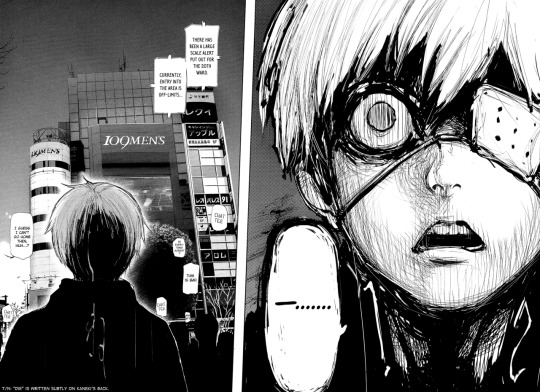
TG 126
Just as there’s a reason Eto was hunted down and forced to work for Arima (and yes, she’s forced to; the moment Arima discovered her identity, she has no choices left) despite Kuzen’s “protection”, there’s a reason that Anteiku was destroyed despite Kaneki’s “protection”. Because destroying Aogiri doesn’t solve the underlying issues that cause threats to Anteiku to begin with.
It doesn’t break the bird cage caused by V, it doesn’t solve the issues between humans and ghouls, it doesn’t even remotely encourage that. Destroying Aogiri doesn’t even solve the immediate threats to Anteiku in Tokyo Ghoul - V, and groups that work with them, like, say, the CCG. The groups who actually targeted Anteiku and actually destroyed it, and not just a theoretical that Kaneki proposed in his head.
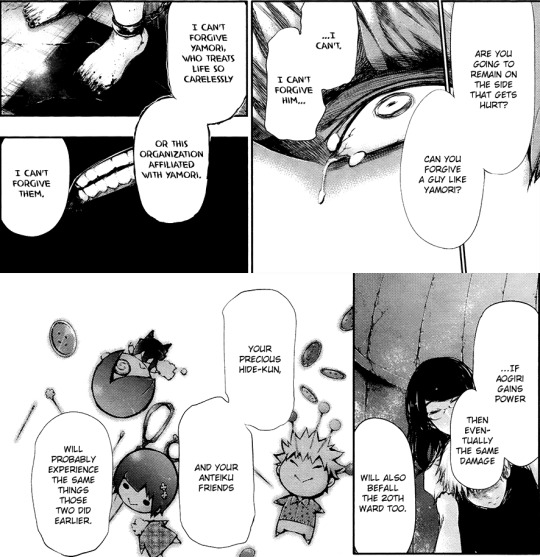
TG 63
Because Aogiri never intended to attack Anteiku, a few individual members did of their own accord. Think about it this way: If they were intending to destroy Anteiku and kill all of its members, why would Ayato be in Aogiri when his goal is to protect Touka? There’s nothing that actually indicated that Aogiri had any interest in Anteiku outside of just checking out Kaneki’s worthiness as a possible One Eyed King.
Tatara, Eto, and Arima never even intended for Kaneki to be tortured in the first place.

TG 54, TG 75
Tatara actively writes off Kaneki and gives him to Ayato, not Yamori. Ayato, as in the guy who angers Yamori, and who Yamori didn’t want to cross. The reason Kaneki was tortured was’t because of Aogiri using Yamori as a roundabout means to do so (why would they bother doing so in such a manner?), it was because of, primarily, Nico’s extensive machinations enabling Yamori to do so.
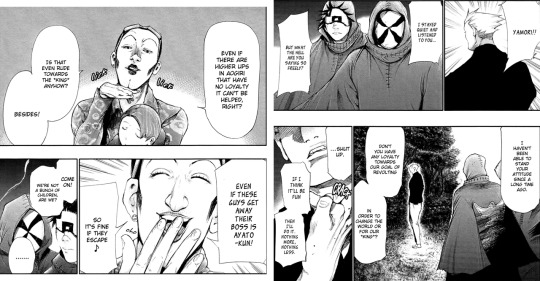
TG 58
Kaneki projected Yamori, a guy who has less in common with the average grunt of Aogiri as Kijima does the random grunt of the CCG, onto the rest of Aogiri Tree. Yamori was legitimately hated by the Aogiri members as a whole, this is made explicit on multiple occasions. Yamori also rather explicitly has literally no loyalty to Aogiri Tree. His motive? “it’ll be fun”.
Yamori torturing Kaneki was explicitly treason here, in the sense that he had to commit treason to do so. The only reason that the Bin Brothers didn’t try to fight Yamori was Nico and the oncoming CCG battle. We’ll leave this at that for now. However, it’s made clear that Nico was the one who enabled Yamori to torture Kaneki by stopping Kaneki’s and the others’ escape at every turn and being the one who lead Yamori to him in the first place.
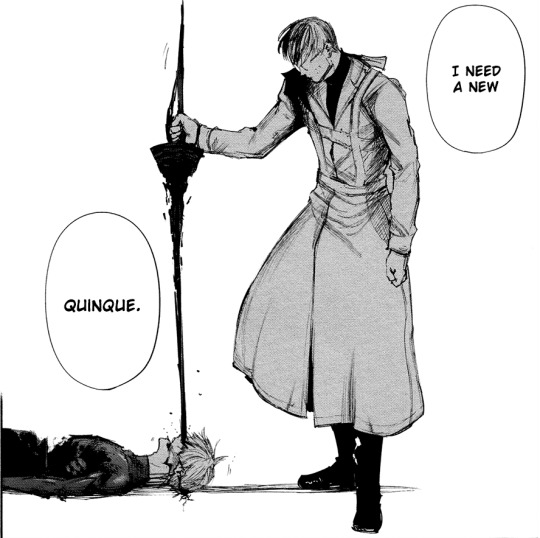
TG 139
The tragedy of the original Tokyo Ghoul wasn’t that Kaneki’s actions amounted to nothing because the CCG’s attack made Kaneki’s actions against Aogiri meaningless, and he decided to shoulder the burden of fighting everyone alone. The tragedy of the original Tokyo Ghoul was that Kaneki didn’t actually protect Anteiku, because his actions had nothing to do with protecting Anteiku. In the end, Kaneki ends up in an unwitting battle against the One Eyed King and is defeated before he can reach his goal of Anteiku. He fought a series of pointless battles against Aogiri, because a Clown set him up.

TG 78
That’s why Nico’s saying all this to Furuta in a chapter called “Diversion”. It’s… literally right there. Eto and Aogiri a diversion for Kaneki from his true goal: being loved and finding happiness. Nico even kind of just outright says they had Kaneki tortured because they wanted to see the changes a human goes through when they enter despair. There is a very, very good reason why Kaneki is always portrayed as being at his worst when he’s going after Eto in both Tokyo Ghoul and Tokyo Ghoul ;re.
They’re mentioning Eto indirectly here, and how she’s not the One Eyed King (Nico lied to Kaneki - not Furuta) to foreshadow quite a bit. The tragedy of the original Tokyo Ghoul was that Kaneki’s actions were meaningless the entire time, that he wasn’t actually fighting the real threats to his loved ones, and he learned the wrong lessons from his experiences.
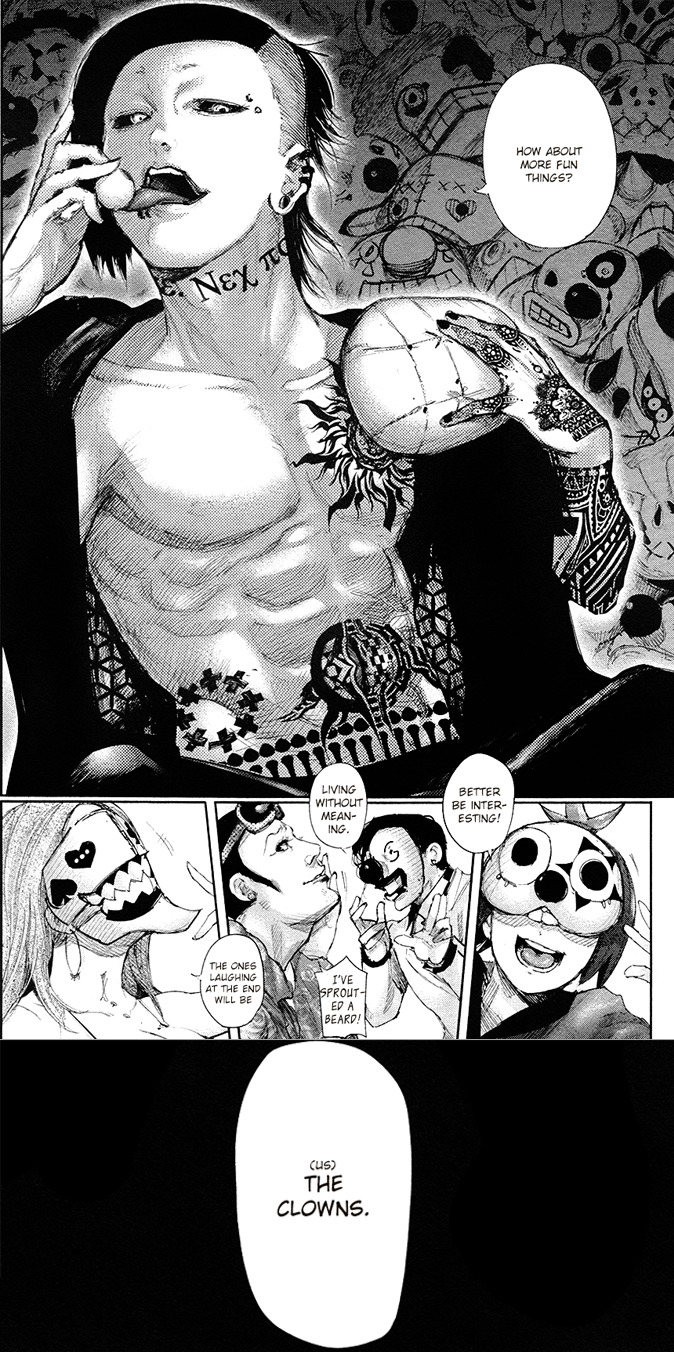
TG 143
That was the point of this entire scene with the Clowns celebrating at the end of Tokyo Ghoul. Like, they’re even referencing Yamori’s line here. Kaneki went on some random warpath against someone who is mostly irrelevant to his happiness and could have even been an ally to him (like Tsukiyama, or Nishki), who eventually became an ally to him in ;re, but not the actual threats to Antieku. Kuzen is the same as Kaneki. That’s how they parallel. The only difference between Kaneki and Kuzen is that Kaneki was tricked and misled, whereas Kuzen wasn’t.

TG;re 71
Kuzen is completely aware of this fact. He knows his actions aren’t actually helping Eto. That’s the subtext here, even if Yomo doesn’t pick up on it. Yoshimura even lampshading that, more often than not, he gets the opposite outcome than what he wants in his statements here.

TG;re 62
I believe this scene to be grossly misinterprreted. The question I usually see pop up here is “Why is Eto getting so unreasonable here, so ungrateful towards her father?” There seems to be this perception that Eto could just walk in through the front door, that Kuzen would just welcome her with open arms. But there’s nothing to suggest that he would.

TG;remake 1, TG;re 62
This novel Eto drops in front of Anteiku is about the longing for parents, or in other words, a family, while living in a hellish situation. Just look how long he lingers on the novel she drops in front of his door. This indicates the novel itself has meaning to him.
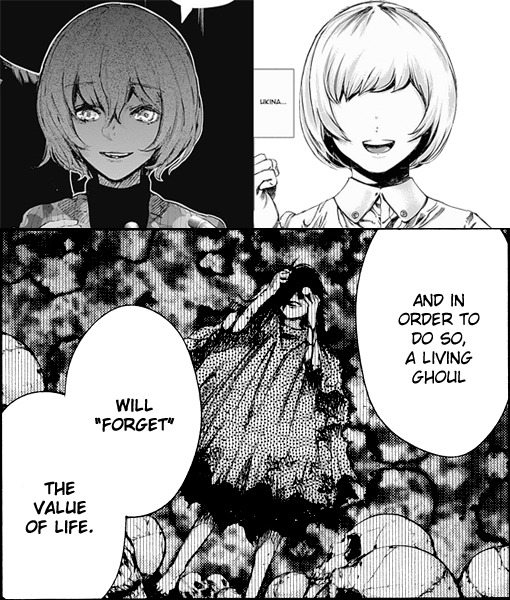
TG;re 63, TG 124, TG 119
Consider that Eto looks just like Ukina. Now consider that Eto makes public appearances and has her novels known around the world. Kuzen even imagines Eto in his mind’s eye during his speech to Kaneki. The implication here is that Kuzen is just as aware of Eto as she is of him. The other implication here is that Kuzen’s lingering on Eto’s novel because he knows she just walked by and dropped the novel as a message to him.
The real question should be “How does Eto know who Kuzen is?”

TG;re 71
The implication here is that Kuzen came forward to Eto. Given his foiling with Touka, and his intentions with Hinami, all point towards one thing: Kuzen’s last embrace of Eto? Wasn’t from when she was a baby. It was probably shortly after she published her novel. That is how he knows V is still pursuing her. That is why she is so angry. That is how Eto knows who he is. That is why Kuzen lingered on Eto’s novel for so long. Kuzen did with Eto the exact same thing he wanted to do with Hinami. Only with Eto, there was no one to tell him “this is wrong”.
Eto started working as a novelist as a 14 year old. Eto was forced to become a child soldier as a 14 year old, fighting a war against V, who controls the entire world, as a 14 year old. Not for her own selfish ends, not for simple revenge, but for the plight of her fellow ghouls.

TG;re 65
And Kuzen’s not helping her, he’s not taking care of her, he’s not taking notice of her, he’s not actually doing anything for her. The opposite of love is not hatred - the opposite of love is indifference. And Kuzen comes off as being completely and utterly indifferent towards Eto’s struggles. Eto’s writing novels about living through hell, because she’s being hunted by V, other ghouls, the CCG, and the only support system she believes she has at that moment is maybe Arima.
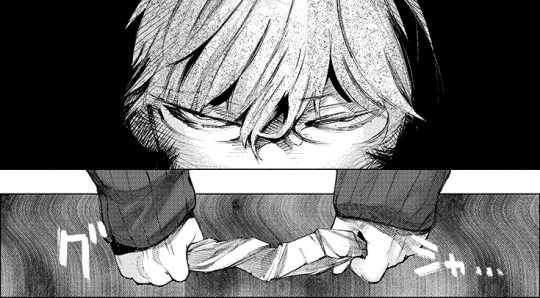
TG;re 62
So when Eto walks by Kuzen having a happy fun time with his new family, while she’s suffering alone, when she’s being hunted by V, she gets upset. And it’s completely understandable. She’s struggling alone.

(this image is from TG 125 and TG;re 71)
Kuzen wished for Eto’s embrace, to have a cup of coffee with her. He created Anteiku as a home for her, the name being an anagram of her name and her mother’s name; but in the end, it never amounted to any more than a wish. V was never going to go away without someone to stop them, and Kuzen had already resigned himself to never be able to do anything to beat them.
Therefore, Eto could never come to Anteiku. Kuzen referred to Eto using such terms with fantastical connotations, but simultaneous common usage, such as “wish” and “miracle”. Perhaps that was by design? Because he knew the arbitrary requirements he designed to be met could never be. These words would have immediate meaning to those around him as merely expressing desire; but in reality, they’re acknowleding it’s pure fantasy.
We’ll contrast Touka’s inaction with Kuzen’s inaction, because they’re two very different things. Both Kuzen and Touka made homes for Eto and Kaneki respectively to return too, and both avoided grabbing them and bringing them to those homes. But the reasoning here is polar opposite.

TG;re 42
Touka doesn’t want to bring Kaneki to this home she made for him because by being part of the CCG, he’s protected. The investigators know his identity, and will search him out if he runs away. Being in CCG custody and under their protection? It’s the safest thing for him. Of course, if he does run, he will always have a home at ;re. Touka is actually ignoring her own wishes, her wish for Kaneki’s return, because she thinks this sacrifice is necessary to keep Kaneki safe - because she believes he’s safer without her.
The other part of this equation is, of course, Haise Sasaki and the members of the CCG. Haise Sasaki is just as much a part of Ken Kaneki as any other “personality”. Haise is not something that can simply be removed from Kaneki.

TG;re 121
Which is something that holds to be true. The moment “Haise Sasaki” became “Ken Kaneki”, Akira Mado stopped associating with him. Because names are not without meaning. Memories are not without meaning. The thing that brought Kaneki to Touka, was the thing that took away Haise from Akira.
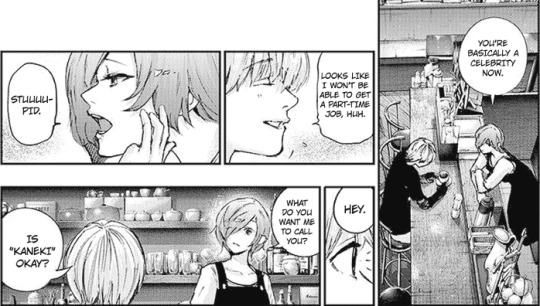
TG;re 99
And in the end, when V and the CCG does come for Kaneki, even after his identity has been exposed and his face plastered all over television? Touka has Kaneki stay at ;re, fulfilling her promise.
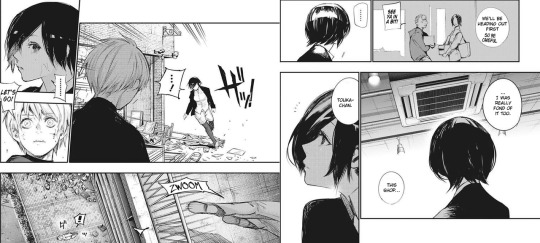
TG;re 124, 123
And Touka is also forced into a situation where she learns there’s an army on its way to her location. So what do she and Kaneki do? They don’t fight a pointless battle they run, sending Kaya and Koma aways instead of forcing them into a suicide battle. While Touka is fond of ;re, she recognizes ;re as what it is: a building. Something that can be rebuilt, an inanimate object. Of course, things don’t go as planned, and Mutsuki, Aura, and the Oggai show up to fight Kaneki.
The violence Kaneki and Touka used here is proportionate to the threat they faced until they can find an opening to leave. Because the important people were sent off. They had already left, because that’s the logical thing to do when you find out an army is approaching your position and there is nothing of strategic value in the place you’re staying at.
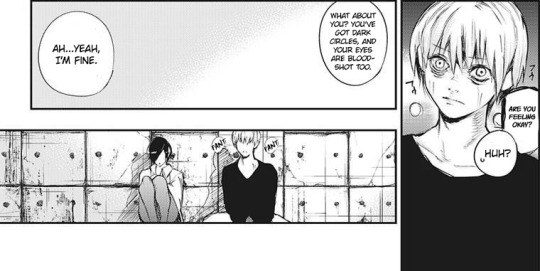
TG;re 130
And even when the CCG followed, Touka still stayed with Kaneki. Compare this to Kuzen’s response to V and the CCG hunting for Eto, his teenaged daughter, who’s identity is not truly known by anybody. And hey, even if they come for you, guess what? Touka has the answer there, too. Touka had an objectively harder job than Kuzen at this point, because Kaneki’s face is now being plastered all over the news. Eto is a… relative nobody. V is hunting her down, they’re trying to kill her, but it’s not like her identity is known to such an extent.
Many people recognized Touka’s parallels to Kuzen with regards to ;re and Anteiku, but I’m not too sure I agree with people about what they meant. The reason Touka succeeded in making a home for Kaneki and Kuzen failed in making a home for Eto wasn’t because Eto “couldn’t understand Kuzen’s love for her”, but because Kuzen never made the right decision, and moreover, knew that in his heart. Touka makes this explicit by rebuffing every decision he makes at every level. That’s why she’s a better manager.
That is not to say that Kuzen didn’t make some very good decisions, because he did.
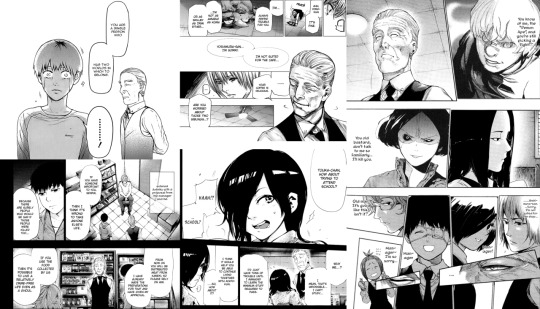
TG 9, TG;re 71, TG 125, TG 71, TG 47
Kaya and Koma were, at one point, violent ghouls who fought others often. Because of Kuzen’s leadership and guidance, they calmed down. They joined him, and became more peaceful. And not just them, but those who followed them.
Or lets use Yomo as another example. Kuzen saves Yomo’s life from Arima, then brings him under his wing. Mellows him out. This is going to be a pattern with Kuzen. Kuzen also saved Yomo’s niece and nephew.
For Touka, Kuzen acts as her father figure and sends her to school. Touka is noted to have “cooled” a lot from this. She established one of her most important relationships here.
For Kaneki, he gives him a family. He tells him, at his weakest moment, he has a place to be. Anteiku is a place of belonging Kaneki discovers when he, as someone who always felt he had nowhere to belong besides Hide, believes he has become a creature alien from both worlds.
He also gives Nishki a way to have relatively moral food. Nishki is also mellowed out by Kuzen’s actions. He becomes far more accustomed to peaceful interactions with others.
It’s just that, if you notice the pattern, none of these good decisions have anything to do with Eto. And indeed, good decisions make people more willing to make people overlook bad decisions. But it doesn’t change the fact that he failed Eto. It doesn’t change the fact that he didn’t help her. It doesn’t change the fact that he got people killed, because of decisions that had immediate, easily seeable answers available to him. But, a reoccuring theme of Tokyo Ghoul is this:
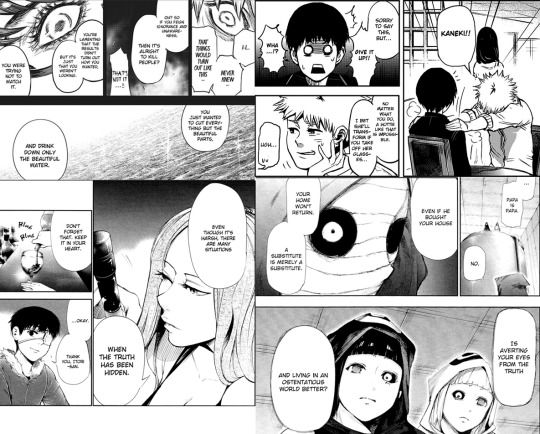
TG;re 159, TG 1, TG 47, TG 98
People really, really, really don’t like to acknowledge the bad. They only want the good. That there is a hidden truth to the world, a darkness, that no one wants to face.

TG 54
It’s best encapsulated by Kaneki’s statement here. Kuzen hid a ton of information from Kaneki - information Kaneki desperately needs. But at the same time, Kuzen gave Kaneki food, a family, counsel, and the ability to do things. Kaneki has very good reason to have doubts in Kuzen, but he writes it off as just his irritation and confusion. Irritation and confusion that was caused in part by Kuzen’s hiding of information from him.
As for why Kuzen treats Eto the way he does? He can say it’s V, but I think it’s more than that. Kuzen has some interesting wording that he uses when he goes on his speeches, pertaining to one thing: “Birth” and its negative effects.
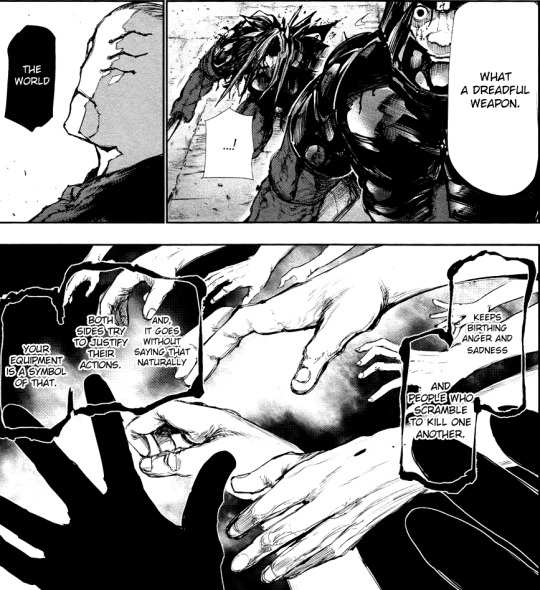
TG 78
He first says it here, relating birth with anger, sadness, death and mass murder. But the best example, the one that gets cited as being “such a good speech”, is the one I want to focus on:

TG 126
“from the instant we are born, we are evil”
His speech itself is in reference to an interpretation to the idea of the Original Sin, which is literally the chapter title. The Original Sin, in the way Kuzen applies it, is the belief that all people are born filled with sin, more or less as Kuzen describes it. This speech itself comes off as kinda cool when you consider how it contrasts with his managerial position at Anteiku, his attitude, and his past, but as Kuzen describe the Original Sin, it’s arguably literally meaningless.
“acts which snatch things away are equally evil”
“life itself means evil”
Kuzen’s statement equates, say, Donato stealing children’s lives with Amon stealing donuts as a child. It’s honestly a really depressing speech. The speech comes off as someone who was forced to kill countless people to survive, and then willingly killed countless more at the behest of a conspiracy, attempting to justify themself. A conclusion so meaningless that “death squad member” is equal to “newborn baby”, which is literally the point, because he’s clearly trying to rationalize his treatment of Eto here with this philosophy.

TG;re 63, TG 119, TG 1, TG 70
Both Eto and Kaneki greatly resemble Arata and Ukina. Kuzen’s killing of Ukina is the darkest moment of his life. It is, quite literally, the only time that we ever see Kuzen shed a tear - that we ever see Kuzen truly express vulnerability to such a level. For Touka, this is a reminder of the good times she had, the more simple times. The time she spent with her father was special to her. Touka has positive memories of her father, who kept his darkness hidden from her; Kuzen has negative memories of Ukina, who he was forced to kill. The resemblances carry emotions that are completely contrasting, and further explain Kuzen’s avoidance of Eto.
“I know that I am ‘evil’, and so are you“
Based off of what Kuzen’s wording here and his mind’s eye view of a “violent ghoul”, he associated Eto with death, with destruction, with evil.

TG 40
Because when he’s describing a ghoul committing senseless murder, he’s thinking constantly of Eto. Eto’s body language actually contradicts his descriptions of course, showing immense stress. This is honestly just Kuzen projecting, which you realize in chapter 119, because he’s describing himself when he was younger and thinking of Eto. He’s literally seeing the worst of himself in Eto. And Eto also sees the worst of Kuzen in herself. That’s part of the reason why she wrote the Black Goat’s Egg.
Kuzen’s rebellion, in the form of the Battle of Anteiku, did nothing that couldn’t have been done better. No one ever got the chance to directly call Kuzen out for what he did, to try to get him to reconsider, Touka being the only one who even considered it, at least not in a way were it was trying to justified his actions. He staged this massive battle that legitimately served no purpose. All because, ostensibly, “for Eto”.

TG;re 86, TG;re 52, TG;re 69
The One Eyed King plan is something that has a limited time table to complete. And if Eto doesn’t do what Arima says, then he could force her to become the One Eyed King by attempting to fight her and killing himself like he did against Kaneki. Which is something Eto doesn’t want, because she thinks everything she touches dies. Because she thinks she’s toxic. I went over this in the Eto’s novels post, but the Black Goat’s Egg is basically about Eto’s self loathing and belief she’s toxic.
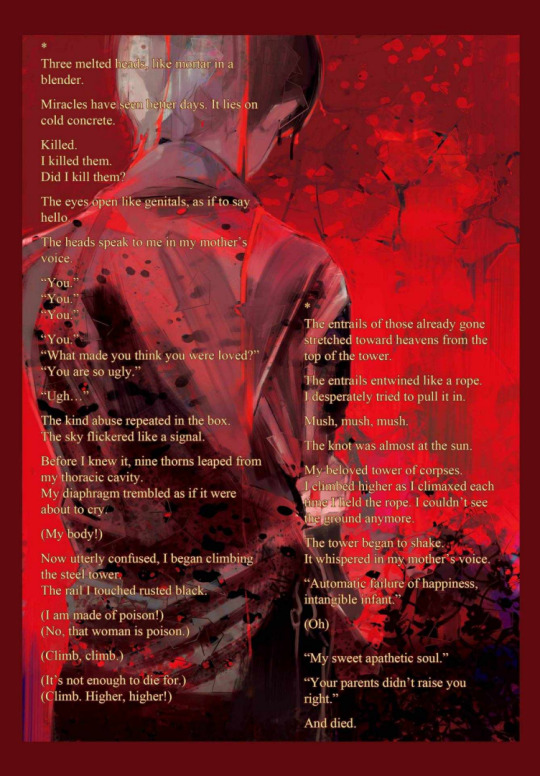
TG;re Vol 5 poem, Black Goat’s Egg excerpt

TG;re 74
There is some inference here, essentially the idea that Arima gave Eto the same choice he gave Kaneki when it came to Touka - it’s not explicitly stated, but there’s some hints. I understand there’s the idea that Kuzen and Eto made no attempt at reconciliation, and that’s actually understandable. But… I’m pretty sure the subtext is they did, because the literal text is that she’s bothered by his passing.
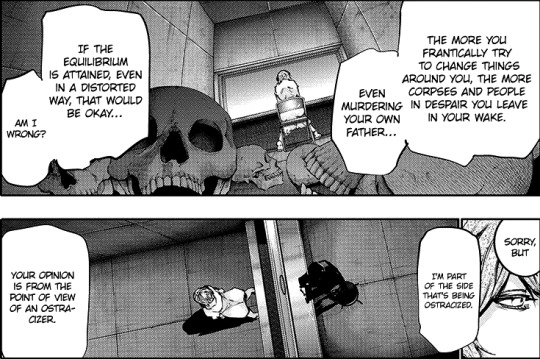
TG;re 65
Furuta brings up Kuzen here, and the death of those around her because of her actions. Something that really grates on Eto. Eto has no real response to Furuta’s points, because these things actually bother her, which is why she just responds with “I’m on the size of the weak, you’re on the side of the strong”. It’s a deflection about
Eto is planning on dying here to atone for her sins. She doesn’t think she’s someone worth living, worth saving. That’s why she smiles in the same manner as Kaneki after making a request for someone to do something they’re already planning on doing, for Kaneki asking Urie to save Mutsuki, and for Eto asking Kaneki to fight Arima. Eto is actually paralleling Kaneki throughout his “Reapernki” and “Shironeki” phases, and these parallels run back 13 years.
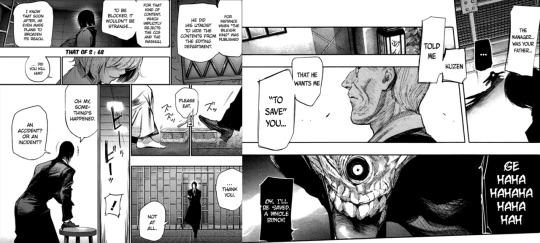
TG;re 68, 55
You’ll notice there was an awkward pause here from Eto that went completely overlooked during this conversation when Kuzen was mentioned by Kaneki. This isn’t her being angry. This is her not having anything to say when he immediately brings him up, the rest of her conversations with Kaneki being constant quick witted banter (that devolves into mentally ill rambling shortly after this, but).
This awkward pausing is actually repeated later, with Eto’s human father figure, Shiono. An awkward pause, followed by a joke. These scenes aren’t a perfect parallel; but they’re rather close.

TG 99, TG;re 119
There’s more hints of course, and it relates to Rize’s treatment by Furuta. You can actually see Rize here and the immense agony she is clearly in. This is a clear cut indication that Kanou donors aren’t given any type of pain supression system, and that more over, they’re fully aware of their surroundings.
Why is all of this relevant?

TG 143, 124
When you cut to Kuzen, if you look closlely you’ll notice that he’s smiling. And it’s in a panel that was paralleling an earlier panel, where he’s miserable when talking with Kaiko (with the panel mentioning Eto’s existence is a betrayal of V), but smiling next to Eto. Pretty hard to do when your body is hooked to machines and being harvested, right? The idea that the last panel we see of Kuzen was drawn this way for no true purpose seems rather unreasonable, no?
You can’t peacefully smile in immense pain like that. But you can if you’re not in immense pain. Kuzen would logically be on painkillers here, and since Kanou didn’t do this for Rize, it would logically be at Eto’s request. Is that a good ending? No. And this also doesn’t excuse what Eto did here. I think that will probably be hard to swallow given the general assumptions surrounding Eto, but I didn’t agree with the idea that Eto didn’t care for her father, because her actions towards him don’t make sense otherwise. I’m also not sure how else someone going through a painful procedure would smile and be completely asleep outside of painkillers.
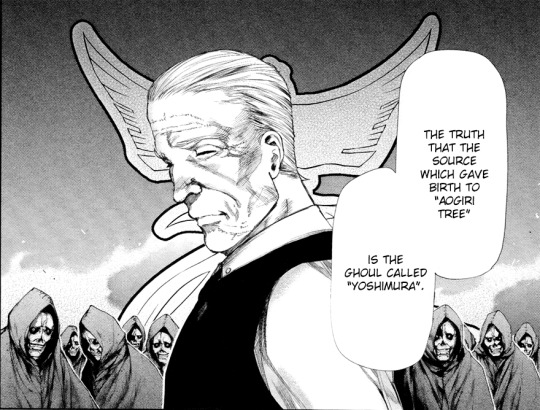
TG 99
It further explains why Furuta knew to use Kuzen against Eto. If Kanou knew Eto cared about killing Kuzen, he would have probably mentioned that to Furuta. Kanou and Furuta were consulting constantly. Kanou knew, back when Kaneki confonted Kanou in his lab, that Kuzen and Eto were related by blood. Kanou had been aware of Kuzen and Eto’s relationship from the beginning.
To get back to Eto, the problem here is that Kuzen’s speech, his entire rebellion against V, is being framed as for Eto, but because how horribly he pulls it off it ends up being against Eto. Because no one actually benefited from the Anteiku battle outside of V; it was demonstrably meaningless in its objectives. But in the end, it wasn’t meaningless to the people it left behind.
Because everyone who survived Anteiku? They all worshiped Kuzen. And Kuzen just staged this massive fight, which meant nothing and did nothing, while framing it as for his daughter who they don’t know. The daughter they’ve been told is a horrible monster. The daughter they believe was the one who was being unreasonable, when Kuzen was the one who decided they could never be together. The daughter who objectively had no control over Kuzen’s actions at any time, but is being blamed for them regardless.

TG;re 75
Eto, of course, ends up saving the Anteiku crew from certain doom not once, but twice. It should be noted that Eto jams up the machinery here befoorehand, too, so even if she fails to manifest her kakujja, the Anteiku crew won’t die.

TG;re 75
And rather than trying to seek understanding or reconciliation they just. Don’t. Ever. Because there’s good reasons to have blood between them, but there’s… no attempt at understanding. Eto sincerely attempts to help them here. She is the only reason they are alive.
The idea she might be saving them because she’s keeping a promise, or she’s trying to help Hinami out, or they’re her fellow ghouls, or she’s Kuzen’s child, and therefore helping out family, doesn’t even enter into their mind.

TG;re 175
They don’t do much of anything both times, there was a refusal to even acknowledge her the second time. She actually shatters the Kuzen quinque, here, too. That’s how they were able to win against Kaiko, because he lost his SSS rated quinque that allowed him to effortlessly dominate them. They were about to be killed by Kaiko, and she’s objectively the reason they’re alive, and there’s a refusal to acknowledge her.
There was a refusal to even acknowledge her existence for the last 80 chapters. They’re literally doing the exact same thing that Yoshimura and Arima did to Eto. Well, except one person:

TG;re 129
#tg meta#tokyo ghoul#Touka Kirishima#kuzen yoshimura#ken kaneki#Eto Yoshimura#ayato kirishima#Renji Yomo#shuu tsukiyama#Arima Kishou#haise sasaki#Akira Mado#hinami fueguchi#Rize Kamishiro#Nimura Furuta#uta#itori
88 notes
·
View notes
Text
Ronin: Kyoji Horiguchi, UFC Contender in Exile
The nostalgic fans were on tenterhooks. The opening to the first day of Rizin’s two day spectacular was relatively tame. Nobuhiko Takada, PRIDE FC’s first headliner and the man who almost knocked out Rickson Gracie, showed up looking dapper but underwhelming in a tuxedo. The alternate MMA fan found himself worrying that Rizin was cutting back on the staggering production values for which PRIDE FC was known. Nobuhiko Takada’s opening ceremony appearance in a fundoshi, or "sumo diaper" for the Westerner, had become a grand tradition in PRIDE. In his Reddit AMA a day earlier, PRIDE founder Nobuyuki Sakakibara had teased fans by stating that he didn’t know if the old style opening ceremony was planned but he knew that the fifty-five year old Takada had been working out.
PRIDE nostalgia is Rizin’s whole trip and it brought back the memories in force when the second day’s broadcast opened on a darkened Saitama Super Arena, a quartet of torches lit on the entrance ramp. Eight men entered in latex robes and in a scene which evoked memories of Stanley Kubrick’s Eyes Wide Shut and the steel mill from The Simpsons, the eight began banging on drums assembled on the stage.
The pyres were extinguished and the arena plunged into darkness once more. The central caped figure stepped forward to raise his hands and reveal that his elbow length latex gloves contained flashlights in each of the fingers. A drum sounded and the entrance way was spotlighted. Two of the drummers began to undress the man with the luminescent fingertips, stripping him down to a latex hakama or "Aikido skirt" and revealing him to be Nobuhiko Takada, inexplicably heralding a gasp from the silent crowd. A drumroll and a fanfare began as Takada marched down the entrance way.
At the end he extended his arms and gazed skyward, before tearing off the skirt to reveal…the diaper.
As the camera cut to a view of Takada’s glistening buttocks, the crowd let out a mild cheer. Takada entered the ring and stood before a giant taiko drum, suspended in the middle of the ring with the Rizin logo on the skin. He paused, waiting for his cue, then missed it and drummed wildly while out of time with the music being played through the arena. This opening ceremony perfectly encapsulated just what Rizin is. It tries new things, and they are often very intriguing, but the old things that just don’t quite work any more are the things which actually bring in the ticket sales and the stream purchases. This writer would rather not linger on a 50-year-old Tsuyoshi Kohsaka coming out of retirement to fight the Mirko Cro Cop who just stopped King Mo and won the Rizin Open Weight Grand Prix, which could only be described as "fucking disgusting." Or on Gabi Garcia missing weight by twenty pounds when matched against a 50-year-old woman. Or on proven world class bantamweight kickboxer, Tenshin Nasukawa, being fed easy knockouts.
No, that is the "bad" and the "ugly" of Rizin. The "good" of Rizin is five feet and five inches of karate fury. His name is Kyoji Horiguchi and he is one of the greatest fighters in the world, serving out a period of self-imposed exile.
The Ronin
Kyoji Horiguchi is the best and most proven fighter today outside of the UFC. There have been plenty who never made it to the big American shows or arrived too late, but Horiguchi is in his athletic prime and currently the most glaring omission on the UFC and Bellator rosters. A flyweight, Horiguchi fell victim to the sausage factory that is the UFC’s flyweight title picture. Why does no one care about Demetrious Johnson when he has defended his title a dozen times? becomes Quick, find someone from the undercard to fight Demetrious Johnson which again becomes Why does no one care about Demetrious Johnson when he has defended his title a dozen times? Horiguchi was green as a goose turd when he was thrown in with the flyweight king and while he showed Johnson some interesting looks on the feet, he wound up losing just the same. Horiguchi still had some serious holes in his game back then and before moving to American Top Team, Horiguchi gave up his back in almost every fight he had, despite being considerably better than most of his opponents.
Working with ATT, Horiguchi has looked better from fight to fight. After picking up his best win to date, over the top ten ranked Ali Bagautinov while stuck on the undercard of a UFC Fight Night event, Horiguchi decided he’d get better treatment in Japan. At the time, we described the move as “perhaps the UFC's greatest failing in recent history,” showing zero anticipation of the year to come. But letting as highly ranked a fighter as Horiguchi go, when he was one of the most exciting and hardest hitting men in the division, was a break with UFC tradition. The aforementioned Bagautinov made the same decision and jumped ship to the Russian promotion, Fight Nights Global.
After making his Rizin debut in April, Horiguchi was entered into the Rizin bantamweight grand prix, ten pounds heavier than his usual fighting weight. He smashed the aged Hideo Tokoro in the opening round back in June, then stopped three men in two nights last weekend to become the tournament champion.
Life After Ippon
The discussion of karate styles is a sticky area where you will always offend someone. You say something like “karate doesn’t really have elbows” referring to karate competition and someone will get offended and say “there are elbows in our kata!” As with every martial art, karate tapers down to whatever the rules of its competition permit. There might be some old geezer out in Thailand declaring that real Muay Thai has headbutts, but you don’t see many Nak Muay who claim half their style is out the window when the headbutt is banned. So for our purposes there are only two styles of karate—points and knockdown. Points is about tagging the opponent first at all costs before the opponent can tag you. Knockdown is a gruelling battle of body punches and high kicks. Andy Hug, Semmy Schilt, and the many top guys from the golden days of K-1 were knockdown stylists. Horiguchi is a points stylist and he might be the best example of it in MMA today.
Points karate is largely built around the reverse punch, gyaku-zuki. Typically to score in competition this comes from about chest height and has to come back to the hip in hikite to score. This leads to the low hands of karate competition. As we noted back in Lyoto Machida and the Double Edged Sword of Competition Karate:
The point sparring system just produces an atrocious attitude to exchanges. A fighter will dive in with a straight punch to the midsection, then pull his hand back to his hip, and turn his back while shouting, to convince the judges that he totally did just score. Often both fighters will pirouette around the mat, mouths open, “selling the point.”
If you do that in MMA you stand a great chance of being cracked after you have landed your punch. As Holly Holm showed the other night, you can land your rear hand perfectly and still get hit with two shots while you admire your work. The old karate mantra of ikken hissatsu or "one strike, certain annihilation" is a good training philosophy, not a guaranteed outcome.
What Horiguchi does so well is burst in to score the point, then continue into something more sensible and "real." Adding a little bit of head movement has made his karate far more reliable in the wild world of four ounce gloves. Most often he’ll blitz in on the 1-2, then weave out to his right side. Many coaches, including Freddie Roach, like weaving out to the right side off right-handed punches because the left hook is an expected counter when the fighter closes the distance to fire his right straight. Or he’ll burst in and immediately stiff arm out to range.
Or he’ll burst in, push his man back and skip up into a left high kick. It’s using that traditional karate burst to get to the inside, and then building off being on the inside before the opponent has time to swing back that makes for that beautiful combination of karate and boxing.
Horiguchi has had a ton of success connecting his right hand, stepping out to his right side and weaving into a left hook. A simple counter punch but one which normally you would see in extended mid-range exchanges in boxing. Closing the range and moving into it as Horiguchi does and as T.J. Dillashaw did to spark Renan Barao the second time is essentially starting the counter without concerning yourself about reacting to the opponent on the inside. In fact, curiously enough during his Shooto run, Horiguchi’s left hook was his main lead and he was considerably wilder in his leaps across the floor.
One of the more interesting differences between Kyoji Horiguchi and other points karateka in MMA like the Machida brothers, is that he doesn’t often switch stances and he seems to prefer being in closed position to open position. Where Lyoto Machida constantly looks for that southpaw counter left straight while leaning outside the lead foot, and Stephen Thompson retreats to throw the southpaw counter left straight through the open side, Horiguchi is always in an orthodox stance, looking for his right hand. And where Machida is often kicking straight into the open side with his rear leg, Horiguchi uses skip up lead leg kicks to attack the body and head on the open side. Very few fighters can get the same pop into a skip up body kick from such a side on stance. This kick forms a double attack with the high kick should the opponent’s right hand get a little low or close to their head.
In the tournament quarter final, Horiguchi was matched against Gabriel Oliveira, a 10-0 fighter from Brazil fresh off a knockout of Tatsuya Kawajiri. Against Oliveira, Japan’s littlest bantamweight looked a class apart.
In karate there are three initiatives—Sen, Sen-no-sen, and Go-no-sen. To hear more about those, check out Ringcraft: The Three Initiatives. But to summarize: Sen is to attack, Go-no-sen is to defend and then attack—or a delayed counter—and Sen-no-sen is to attack as the opponent attacks—a simultaneous or intercepting counter. Horiguchi burst in on Oliveira, weaved his head out after his right hand, but Oliveira had run a mile. As Oliveira stepped back in to kick, Horiguchi intercepted him. Sen-no-sen is considered the highest level technique in karate, and of course was the focal point of Bruce Lee’s philosophy: Jeet Kune Do, meaning "The Way of the Intercepting Fist."
This is how most karate competitions go—you are trying to get in as fast as possible, or away as fast as possible, and if you can convince your opponent you’re running but actually step in as he does, you’ve made a perfect collision. This was both Lyoto and Chinzo Machida’s main method for accumulating knockdowns and knockouts without tremendous hitting power.
As a bonus—for all of his big bursts across the floor, Horiguchi uses the low line side kick in just the subtle way you like to see. There are two ways to use it: to keep someone the hell away from you, and to annoy and set up further attacks. Both of those are helped along by planting the foot straight on the opponent’s knee as you bounce in. Pulling the knee up to the chest and stomping down as hard as possible—as Yair Rodriguez always does—simply results in the opponent running a mile and you missing the second part of your sick two-touch combo by even further.
Why the Ring Ruins MMA
Horiguchi’s semi-final opponent probably should have been Ian McCall. Unfortunately McCall had a run in with an old gypsy woman some time a couple of years back and now can only fulfil his wish of fighting in a slightly twisted, Bedazzled kind of way. In his hotly anticipate Rizin debut, McCall was given a badass entrance, got all the way into the first minute of the first round, and lacerated his face on the ring rope before a single decent strike was connected.
The ring is and always has been terrible for mixed martial arts. It offers better visibility for the floor seats, but that is quite literally all that can be noted in the "advantages" column. The corners make for more interesting ringcraft, but that could just as easily be done with a square cage. The main advantage of a cage, of course, is that every time a man is pushed into it his arse doesn’t fall through between the links and have to be held up by a team of white gloved referees on the outside. And when a man is taken down in the cage he cannot dive underneath the bottom rope, or poke his head over the bottom rope to avoid being punched in the head.
Anyone who pretends the ring somehow prevents stalling in a standing clinch is wearing rose tinted glasses because just as many PRIDE fights turned into clinch slogs as UFC fights. Furthermore any time won back from wall clinches is quickly re-assigned to the hundreds of resets needed on any event using a ring. Not a single match on this Rizin event or any other avoided an exchange being negatively affected by the use of the ring. Still, no one fell head first into the floor and was asked to continue fighting this time, which is always a blessing.
So in the second round of the tournament, Horiguchi met Manel Kape. A 9-1 fighter who had just got by Ian McCall by TKO (rope burn), then celebrated as if he had done something incredible, turning the crowd even further against him. Kape could hit and he could take a shot. He had a couple inches of height and reach on the former flyweight Horiguchi, but he too looked completely outclassed. Being pushed like a Krazy Horse Bennett with actual ability, Kape resorted to trying to no-sell Horiguchi’s cracking right hands, and ducking in on Horiguchi’s hips whenever the karateka jumped in thinking he had the finish in his sights.
Horiguchi landed many good right hands on Kape as he burst in and many on the counter, but some of his more spectacular moments came as he wedged his way up the inside of kicks. It can be seen as sort of a kamikaze attitude but intercepting counters up the center of round kicks or sliding down the side of straight kicks are among the most powerful techniques that competition karate can teach you.
That’s not to say Horiguchi escaped unscathed, one of his great stylistic disadvantages was thrown into the spotlight. If you burst in like a bolt from the blue, you have to hope that it is your striking surfaces that are doing the colliding and not something more integral to your consciousness. On one of his many bursts in against Kape, Horiguchi ran face first onto the top of a ducking Kape’s head. This "nodder" was accidental but when done deliberately it has been a great way to settle down aggressive fighters since boxers first realized their skulls were a lot harder than their gloves.
In the tournament final, Horiguchi met Shintaro Ishiwatari and despite a long, checkered, and decision-victory filled record, Ishiwatari had a good idea of what to do. Waiting for Horiguchi to burst in, he was hoping to make Horiguchi reach and then check hook the shorter fighter.
Unfortunately, outside of a decent attempt at kneeing Horiguchi as he stepped in to intercept, Ishiwatari didn’t get much going. Taken down off that knee, Ishiwatari was essentially TKO’d while caught up in the ropes behind the ring post at the end of the first round.
Just the ring getting in the way of the action, yet again.
Ishiwatari, understandably groggy, came out wild and ran onto an easy thread-the-needle counter right straight as soon as the second round started.
While his opponents were not the best bantamweights in the world, Horiguchi’s work against three good fighters over two nights, a weight class above his own, garnered him the kind of attention he has deserved for a while. On the mathematically ranked FightMatrix he broke the worldwide bantamweight top ten—though that seems a bit much. But Horiguchi stands out as the biggest of fish in Rizin’s still small pond. Not only is he lacking quality opposition in either of his weightclasses, he is working under an outdated rule set and without one of the most important aspects of modern MMA, the cage. If Rizin could build the kind of roster that makes Horiguchi a viable alter rex for the flyweight division, that would be wonderful for Japanese MMA and the ring would become a viable alternative for top tier fighters rather than a gimmick wheeled out a couple of times a year. But if it cannot—and that is the more likely outcome—we can only hope that Horiguchi’s time back in Japan is a sabbatical and that the UFC soon comes to its senses. UFC should not only throw money at Horiguchi—that would not solve the problem that allegedly caused him to leave—it should give him the position and promotion that his style so deserves.
Pick up Jack’s book, Notorious: The Life and Fights of Conor McGregor and follow him on Twitter @JackSlackMMA.
Ronin: Kyoji Horiguchi, UFC Contender in Exile published first on http://ift.tt/2pLTmlv
0 notes
Text
Ronin: Kyoji Horiguchi, UFC Contender in Exile
The nostalgic fans were on tenterhooks. The opening to the first day of Rizin’s two day spectacular was relatively tame. Nobuhiko Takada, PRIDE FC’s first headliner and the man who almost knocked out Rickson Gracie, showed up looking dapper but underwhelming in a tuxedo. The alternate MMA fan found himself worrying that Rizin was cutting back on the staggering production values for which PRIDE FC was known. Nobuhiko Takada’s opening ceremony appearance in a fundoshi, or “sumo diaper” for the Westerner, had become a grand tradition in PRIDE. In his Reddit AMA a day earlier, PRIDE founder Nobuyuki Sakakibara had teased fans by stating that he didn’t know if the old style opening ceremony was planned but he knew that the fifty-five year old Takada had been working out.
PRIDE nostalgia is Rizin’s whole trip and it brought back the memories in force when the second day’s broadcast opened on a darkened Saitama Super Arena, a quartet of torches lit on the entrance ramp. Eight men entered in latex robes and in a scene which evoked memories of Stanley Kubrick’s Eyes Wide Shut and the steel mill from The Simpsons, the eight began banging on drums assembled on the stage.
The pyres were extinguished and the arena plunged into darkness once more. The central caped figure stepped forward to raise his hands and reveal that his elbow length latex gloves contained flashlights in each of the fingers. A drum sounded and the entrance way was spotlighted. Two of the drummers began to undress the man with the luminescent fingertips, stripping him down to a latex hakama or “Aikido skirt” and revealing him to be Nobuhiko Takada, inexplicably heralding a gasp from the silent crowd. A drumroll and a fanfare began as Takada marched down the entrance way.
At the end he extended his arms and gazed skyward, before tearing off the skirt to reveal…the diaper.
As the camera cut to a view of Takada’s glistening buttocks, the crowd let out a mild cheer. Takada entered the ring and stood before a giant taiko drum, suspended in the middle of the ring with the Rizin logo on the skin. He paused, waiting for his cue, then missed it and drummed wildly while out of time with the music being played through the arena.
This opening ceremony perfectly encapsulated just what Rizin is. It tries new things, and they are often very intriguing, but the old things that just don’t quite work any more are the things which actually bring in the ticket sales and the stream purchases. This writer would rather not linger on a 50-year-old Tsuyoshi Kohsaka coming out of retirement to fight the Mirko Cro Cop who just stopped King Mo and won the Rizin Open Weight Grand Prix, which could only be described as “fucking disgusting.” Or on Gabi Garcia missing weight by twenty pounds when matched against a 50-year-old woman. Or on proven world class bantamweight kickboxer, Tenshin Nasukawa, being fed easy knockouts.
No, that is the “bad” and the “ugly” of Rizin. The “good” of Rizin is five feet and five inches of karate fury. His name is Kyoji Horiguchi and he is one of the greatest fighters in the world, serving out a period of self-imposed exile.
The Ronin
Kyoji Horiguchi is the best and most proven fighter today outside of the UFC. There have been plenty who never made it to the big American shows or arrived too late, but Horiguchi is in his athletic prime and currently the most glaring omission on the UFC and Bellator rosters. A flyweight, Horiguchi fell victim to the sausage factory that is the UFC’s flyweight title picture. Why does no one care about Demetrious Johnson when he has defended his title a dozen times? becomes Quick, find someone from the undercard to fight Demetrious Johnson which again becomes Why does no one care about Demetrious Johnson when he has defended his title a dozen times? Horiguchi was green as a goose turd when he was thrown in with the flyweight king and while he showed Johnson some interesting looks on the feet, he wound up losing just the same. Horiguchi still had some serious holes in his game back then and before moving to American Top Team, Horiguchi gave up his back in almost every fight he had, despite being considerably better than most of his opponents.
Working with ATT, Horiguchi has looked better from fight to fight. After picking up his best win to date, over the top ten ranked Ali Bagautinov while stuck on the undercard of a UFC Fight Night event, Horiguchi decided he’d get better treatment in Japan. At the time, we described the move as “perhaps the UFC’s greatest failing in recent history,” showing zero anticipation of the year to come. But letting as highly ranked a fighter as Horiguchi go, when he was one of the most exciting and hardest hitting men in the division, was a break with UFC tradition. The aforementioned Bagautinov made the same decision and jumped ship to the Russian promotion, Fight Nights Global.
After making his Rizin debut in April, Horiguchi was entered into the Rizin bantamweight grand prix, ten pounds heavier than his usual fighting weight. He smashed the aged Hideo Tokoro in the opening round back in June, then stopped three men in two nights last weekend to become the tournament champion.
Life After Ippon
The discussion of karate styles is a sticky area where you will always offend someone. You say something like “karate doesn’t really have elbows” referring to karate competition and someone will get offended and say “there are elbows in our kata!” As with every martial art, karate tapers down to whatever the rules of its competition permit. There might be some old geezer out in Thailand declaring that real Muay Thai has headbutts, but you don’t see many Nak Muay who claim half their style is out the window when the headbutt is banned. So for our purposes there are only two styles of karate—points and knockdown. Points is about tagging the opponent first at all costs before the opponent can tag you. Knockdown is a gruelling battle of body punches and high kicks. Andy Hug, Semmy Schilt, and the many top guys from the golden days of K-1 were knockdown stylists. Horiguchi is a points stylist and he might be the best example of it in MMA today.
Points karate is largely built around the reverse punch, gyaku-zuki. Typically to score in competition this comes from about chest height and has to come back to the hip in hikite to score. This leads to the low hands of karate competition. As we noted back in Lyoto Machida and the Double Edged Sword of Competition Karate:
The point sparring system just produces an atrocious attitude to exchanges. A fighter will dive in with a straight punch to the midsection, then pull his hand back to his hip, and turn his back while shouting, to convince the judges that he totally did just score. Often both fighters will pirouette around the mat, mouths open, “selling the point.”
If you do that in MMA you stand a great chance of being cracked after you have landed your punch. As Holly Holm showed the other night, you can land your rear hand perfectly and still get hit with two shots while you admire your work. The old karate mantra of ikken hissatsu or “one strike, certain annihilation” is a good training philosophy, not a guaranteed outcome.
What Horiguchi does so well is burst in to score the point, then continue into something more sensible and “real.” Adding a little bit of head movement has made his karate far more reliable in the wild world of four ounce gloves. Most often he’ll blitz in on the 1-2, then weave out to his right side. Many coaches, including Freddie Roach, like weaving out to the right side off right-handed punches because the left hook is an expected counter when the fighter closes the distance to fire his right straight. Or he’ll burst in and immediately stiff arm out to range.
Or he’ll burst in, push his man back and skip up into a left high kick. It’s using that traditional karate burst to get to the inside, and then building off being on the inside before the opponent has time to swing back that makes for that beautiful combination of karate and boxing.
Horiguchi has had a ton of success connecting his right hand, stepping out to his right side and weaving into a left hook. A simple counter punch but one which normally you would see in extended mid-range exchanges in boxing. Closing the range and moving into it as Horiguchi does and as T.J. Dillashaw did to spark Renan Barao the second time is essentially starting the counter without concerning yourself about reacting to the opponent on the inside. In fact, curiously enough during his Shooto run, Horiguchi’s left hook was his main lead and he was considerably wilder in his leaps across the floor.
One of the more interesting differences between Kyoji Horiguchi and other points karateka in MMA like the Machida brothers, is that he doesn’t often switch stances and he seems to prefer being in closed position to open position. Where Lyoto Machida constantly looks for that southpaw counter left straight while leaning outside the lead foot, and Stephen Thompson retreats to throw the southpaw counter left straight through the open side, Horiguchi is always in an orthodox stance, looking for his right hand. And where Machida is often kicking straight into the open side with his rear leg, Horiguchi uses skip up lead leg kicks to attack the body and head on the open side. Very few fighters can get the same pop into a skip up body kick from such a side on stance. This kick forms a double attack with the high kick should the opponent’s right hand get a little low or close to their head.
In the tournament quarter final, Horiguchi was matched against Gabriel Oliveira, a 10-0 fighter from Brazil fresh off a knockout of Tatsuya Kawajiri. Against Oliveira, Japan’s littlest bantamweight looked a class apart.
In karate there are three initiatives—Sen, Sen-no-sen, and Go-no-sen. To hear more about those, check out Ringcraft: The Three Initiatives. But to summarize: Sen is to attack, Go-no-sen is to defend and then attack—or a delayed counter—and Sen-no-sen is to attack as the opponent attacks—a simultaneous or intercepting counter. Horiguchi burst in on Oliveira, weaved his head out after his right hand, but Oliveira had run a mile. As Oliveira stepped back in to kick, Horiguchi intercepted him. Sen-no-sen is considered the highest level technique in karate, and of course was the focal point of Bruce Lee’s philosophy: Jeet Kune Do, meaning “The Way of the Intercepting Fist.”
This is how most karate competitions go—you are trying to get in as fast as possible, or away as fast as possible, and if you can convince your opponent you’re running but actually step in as he does, you’ve made a perfect collision. This was both Lyoto and Chinzo Machida’s main method for accumulating knockdowns and knockouts without tremendous hitting power.
As a bonus—for all of his big bursts across the floor, Horiguchi uses the low line side kick in just the subtle way you like to see. There are two ways to use it: to keep someone the hell away from you, and to annoy and set up further attacks. Both of those are helped along by planting the foot straight on the opponent’s knee as you bounce in. Pulling the knee up to the chest and stomping down as hard as possible—as Yair Rodriguez always does—simply results in the opponent running a mile and you missing the second part of your sick two-touch combo by even further.
Why the Ring Ruins MMA
Horiguchi’s semi-final opponent probably should have been Ian McCall. Unfortunately McCall had a run in with an old gypsy woman some time a couple of years back and now can only fulfil his wish of fighting in a slightly twisted, Bedazzled kind of way. In his hotly anticipate Rizin debut, McCall was given a badass entrance, got all the way into the first minute of the first round, and lacerated his face on the ring rope before a single decent strike was connected.
The ring is and always has been terrible for mixed martial arts. It offers better visibility for the floor seats, but that is quite literally all that can be noted in the “advantages” column. The corners make for more interesting ringcraft, but that could just as easily be done with a square cage. The main advantage of a cage, of course, is that every time a man is pushed into it his arse doesn’t fall through between the links and have to be held up by a team of white gloved referees on the outside. And when a man is taken down in the cage he cannot dive underneath the bottom rope, or poke his head over the bottom rope to avoid being punched in the head.
Anyone who pretends the ring somehow prevents stalling in a standing clinch is wearing rose tinted glasses because just as many PRIDE fights turned into clinch slogs as UFC fights. Furthermore any time won back from wall clinches is quickly re-assigned to the hundreds of resets needed on any event using a ring. Not a single match on this Rizin event or any other avoided an exchange being negatively affected by the use of the ring. Still, no one fell head first into the floor and was asked to continue fighting this time, which is always a blessing.
So in the second round of the tournament, Horiguchi met Manel Kape. A 9-1 fighter who had just got by Ian McCall by TKO (rope burn), then celebrated as if he had done something incredible, turning the crowd even further against him. Kape could hit and he could take a shot. He had a couple inches of height and reach on the former flyweight Horiguchi, but he too looked completely outclassed. Being pushed like a Krazy Horse Bennett with actual ability, Kape resorted to trying to no-sell Horiguchi’s cracking right hands, and ducking in on Horiguchi’s hips whenever the karateka jumped in thinking he had the finish in his sights.
Horiguchi landed many good right hands on Kape as he burst in and many on the counter, but some of his more spectacular moments came as he wedged his way up the inside of kicks. It can be seen as sort of a kamikaze attitude but intercepting counters up the center of round kicks or sliding down the side of straight kicks are among the most powerful techniques that competition karate can teach you.
That’s not to say Horiguchi escaped unscathed, one of his great stylistic disadvantages was thrown into the spotlight. If you burst in like a bolt from the blue, you have to hope that it is your striking surfaces that are doing the colliding and not something more integral to your consciousness. On one of his many bursts in against Kape, Horiguchi ran face first onto the top of a ducking Kape’s head. This “nodder” was accidental but when done deliberately it has been a great way to settle down aggressive fighters since boxers first realized their skulls were a lot harder than their gloves.
In the tournament final, Horiguchi met Shintaro Ishiwatari and despite a long, checkered, and decision-victory filled record, Ishiwatari had a good idea of what to do. Waiting for Horiguchi to burst in, he was hoping to make Horiguchi reach and then check hook the shorter fighter.
Unfortunately, outside of a decent attempt at kneeing Horiguchi as he stepped in to intercept, Ishiwatari didn’t get much going. Taken down off that knee, Ishiwatari was essentially TKO’d while caught up in the ropes behind the ring post at the end of the first round.
Just the ring getting in the way of the action, yet again.
Ishiwatari, understandably groggy, came out wild and ran onto an easy thread-the-needle counter right straight as soon as the second round started.
While his opponents were not the best bantamweights in the world, Horiguchi’s work against three good fighters over two nights, a weight class above his own, garnered him the kind of attention he has deserved for a while. On the mathematically ranked FightMatrix he broke the worldwide bantamweight top ten—though that seems a bit much. But Horiguchi stands out as the biggest of fish in Rizin’s still small pond. Not only is he lacking quality opposition in either of his weightclasses, he is working under an outdated rule set and without one of the most important aspects of modern MMA, the cage. If Rizin could build the kind of roster that makes Horiguchi a viable alter rex for the flyweight division, that would be wonderful for Japanese MMA and the ring would become a viable alternative for top tier fighters rather than a gimmick wheeled out a couple of times a year. But if it cannot—and that is the more likely outcome—we can only hope that Horiguchi’s time back in Japan is a sabbatical and that the UFC soon comes to its senses. UFC should not only throw money at Horiguchi—that would not solve the problem that allegedly caused him to leave—it should give him the position and promotion that his style so deserves.
Pick up Jack’s book, Notorious: The Life and Fights of Conor McGregor and follow him on Twitter @JackSlackMMA.
Ronin: Kyoji Horiguchi, UFC Contender in Exile syndicated from http://ift.tt/2ug2Ns6
0 notes